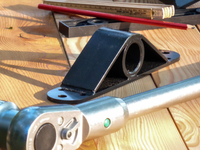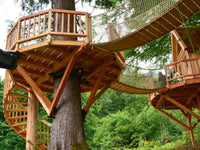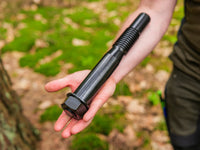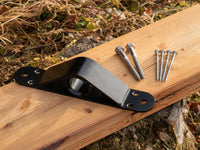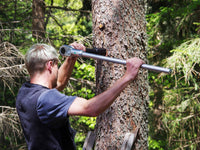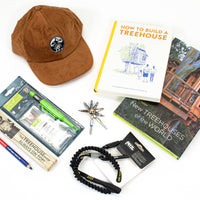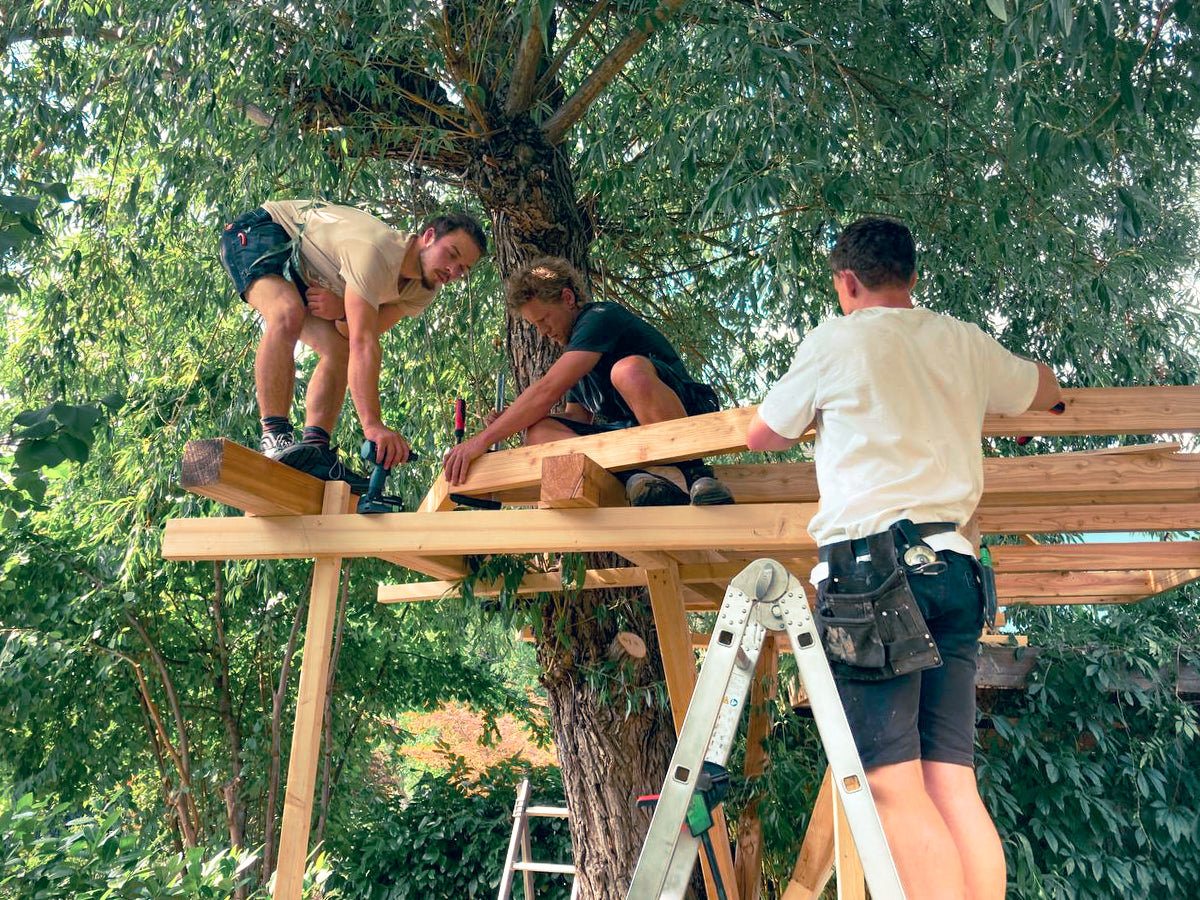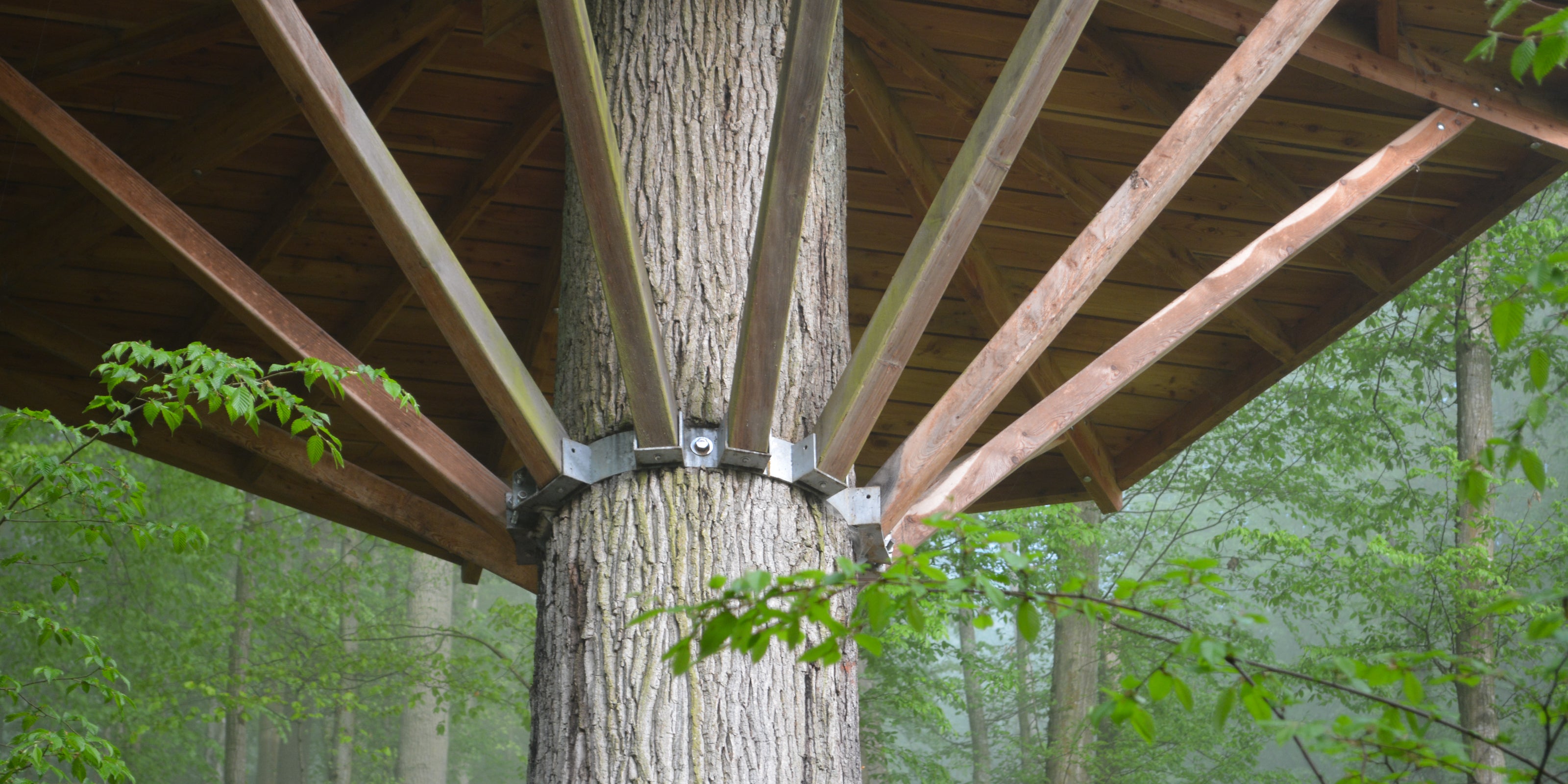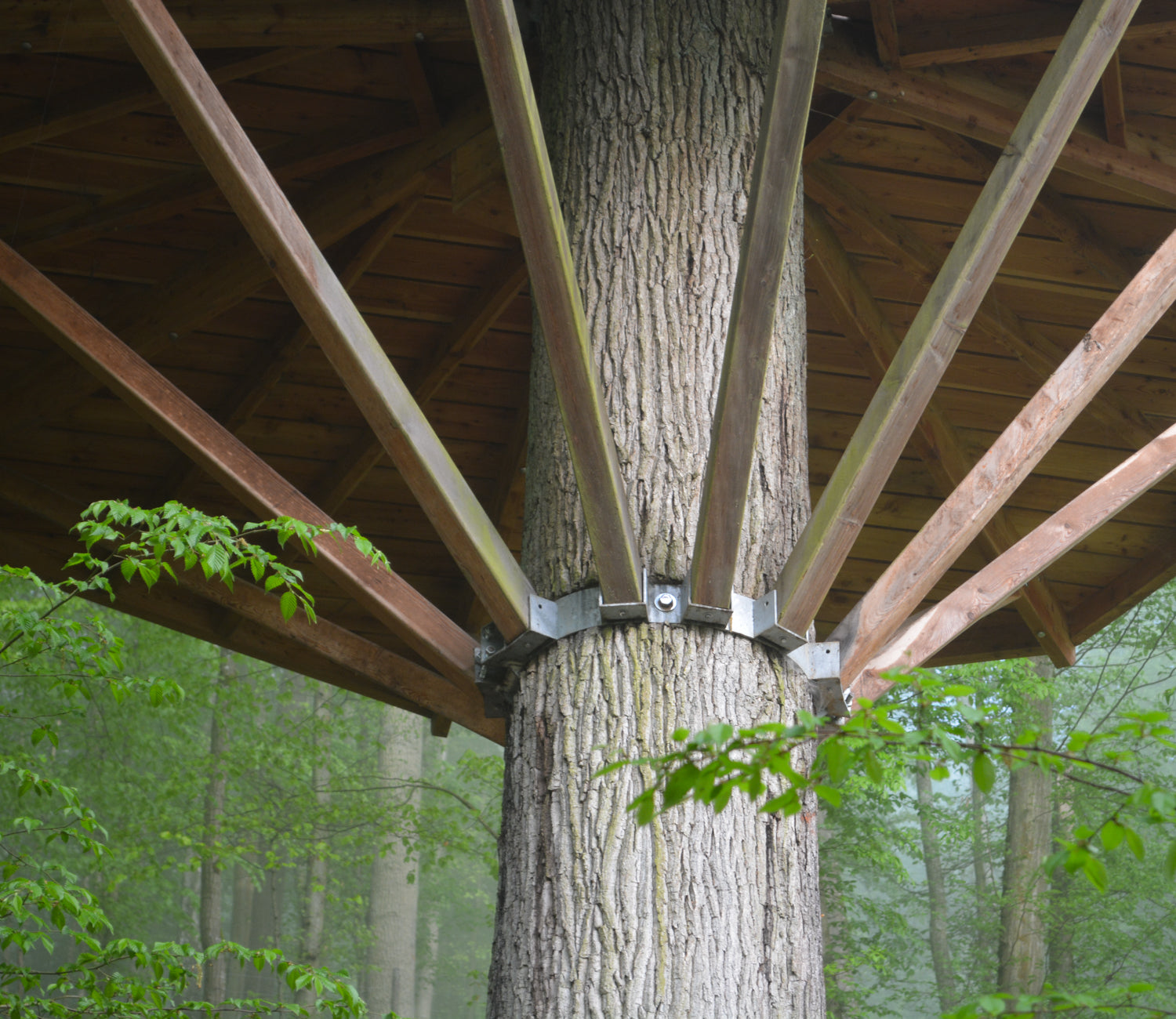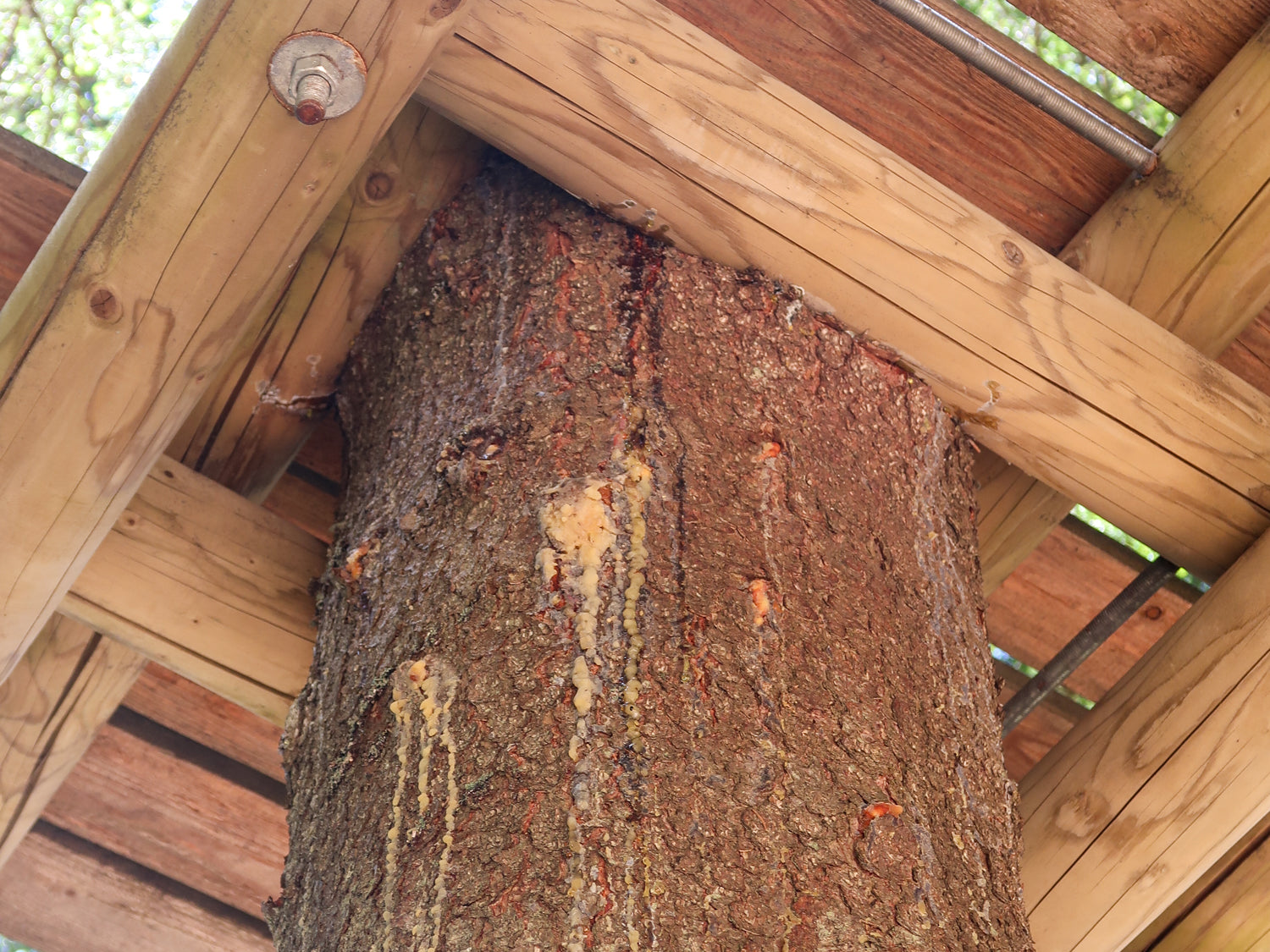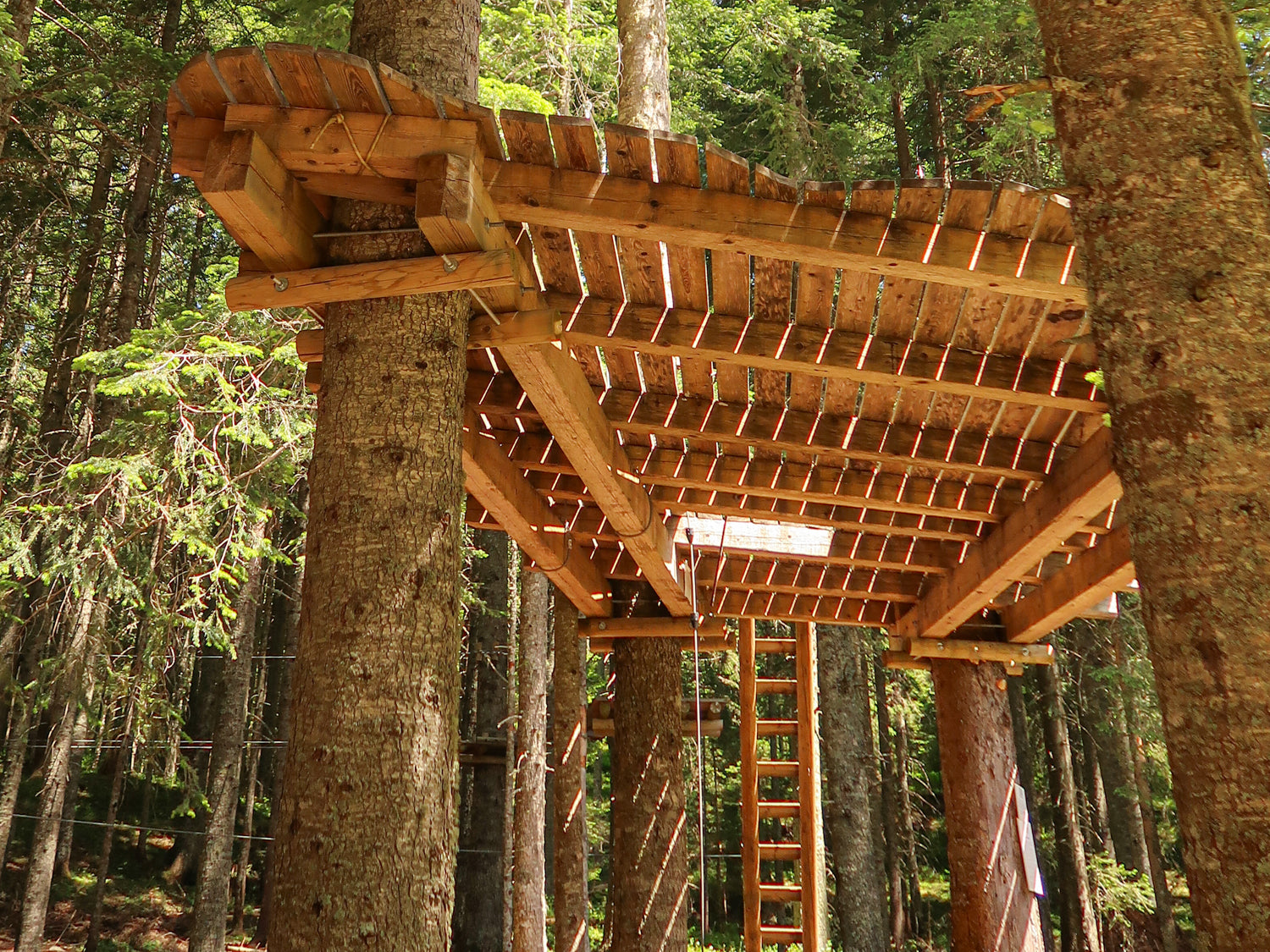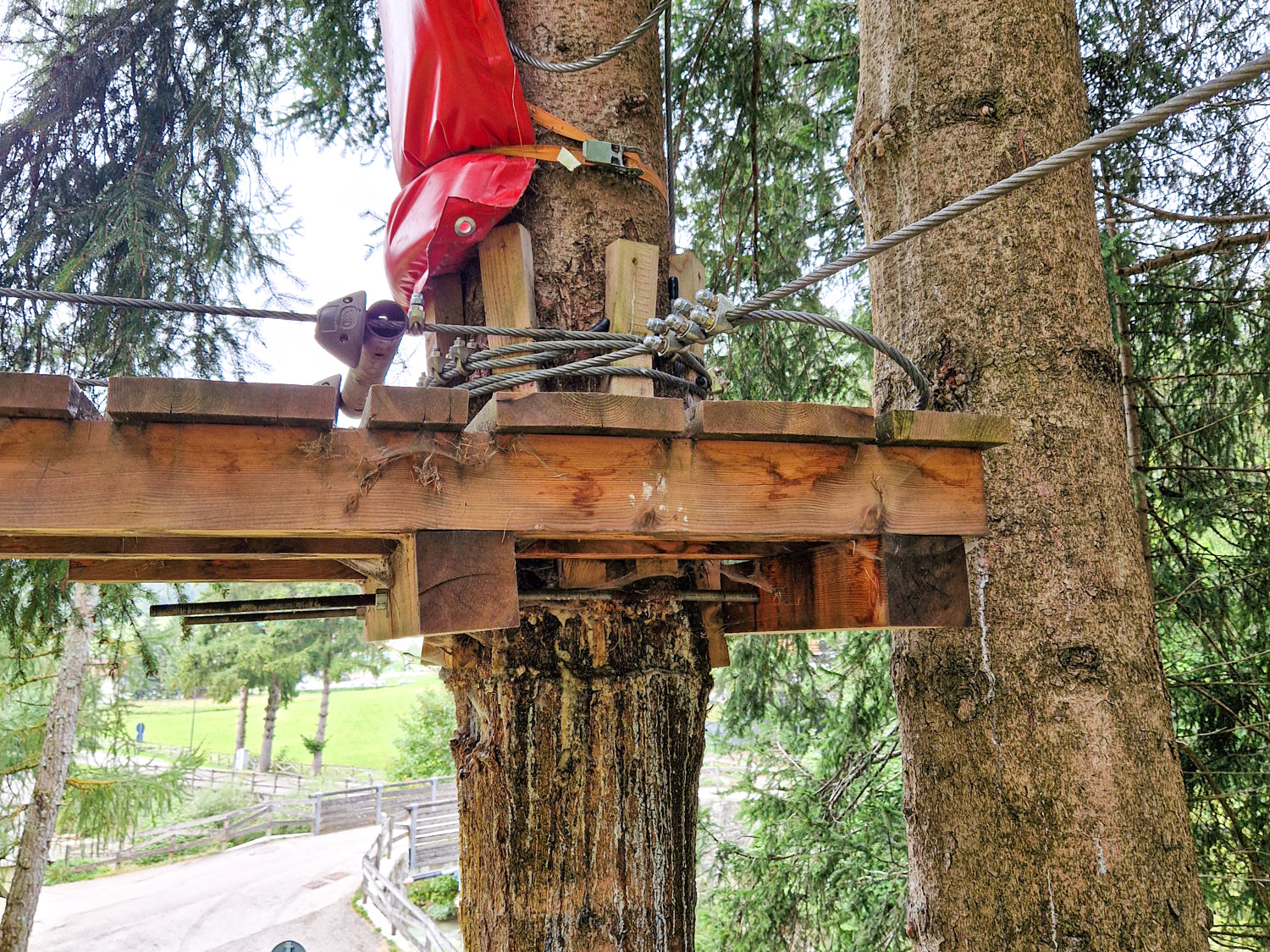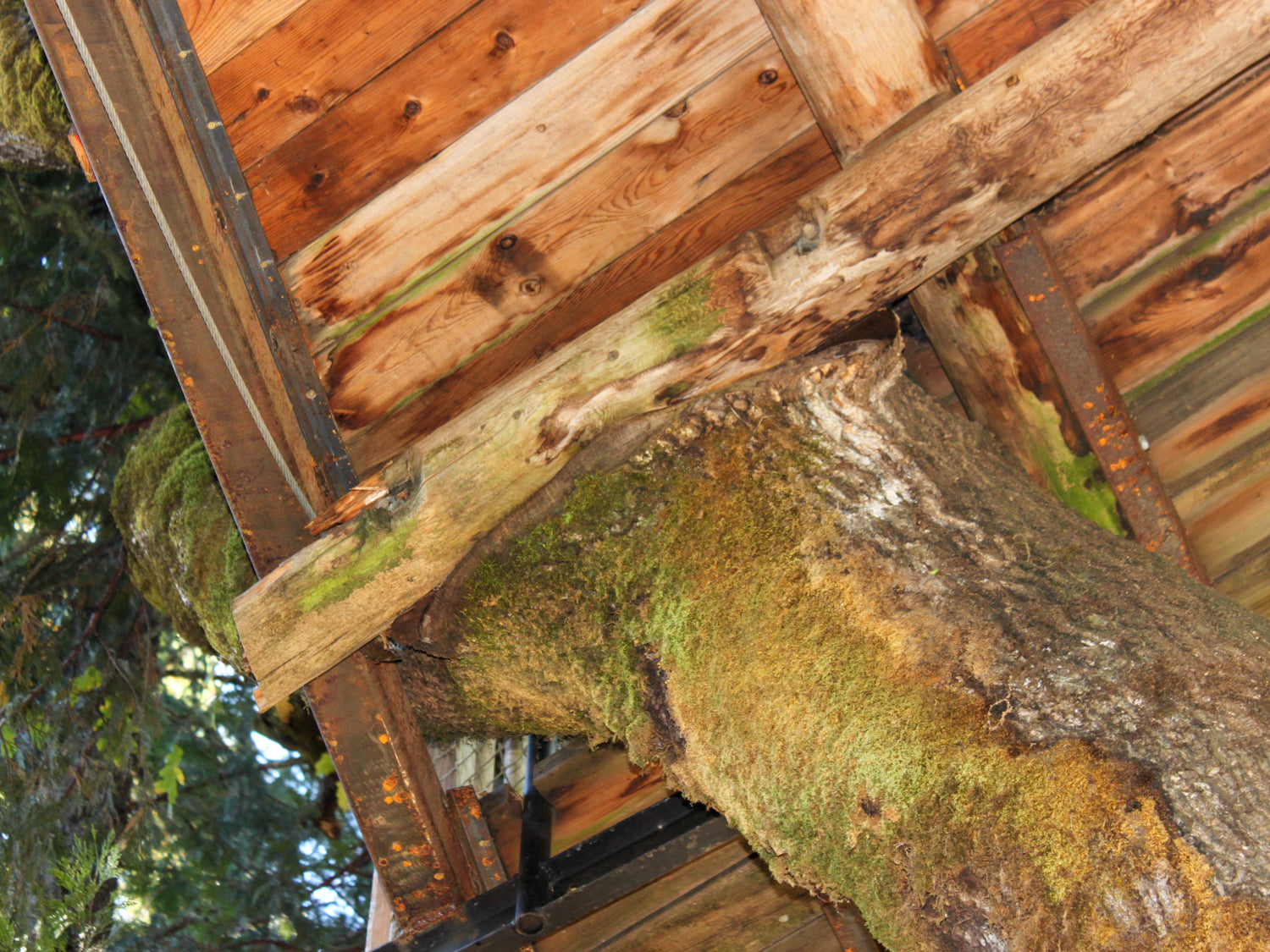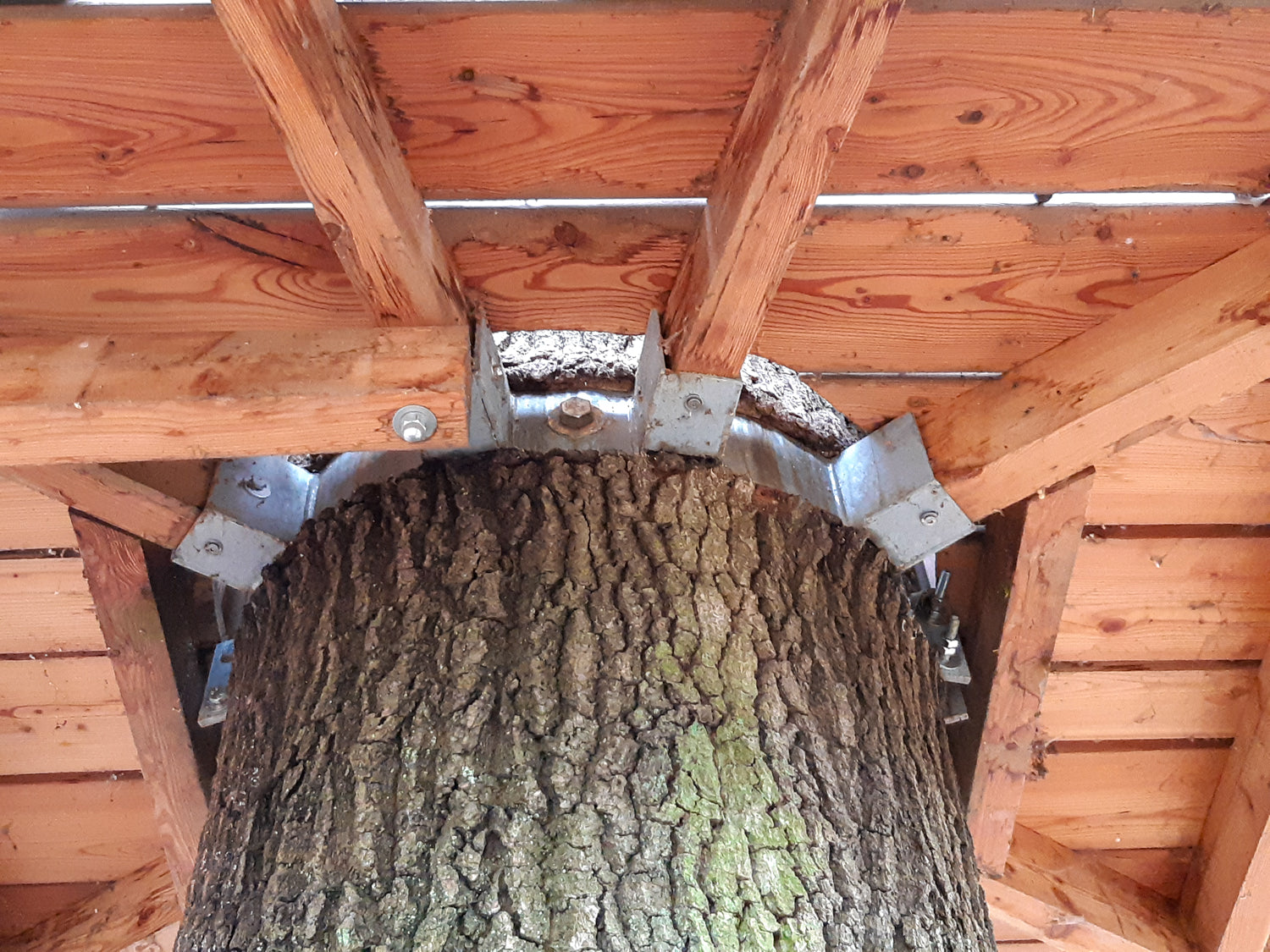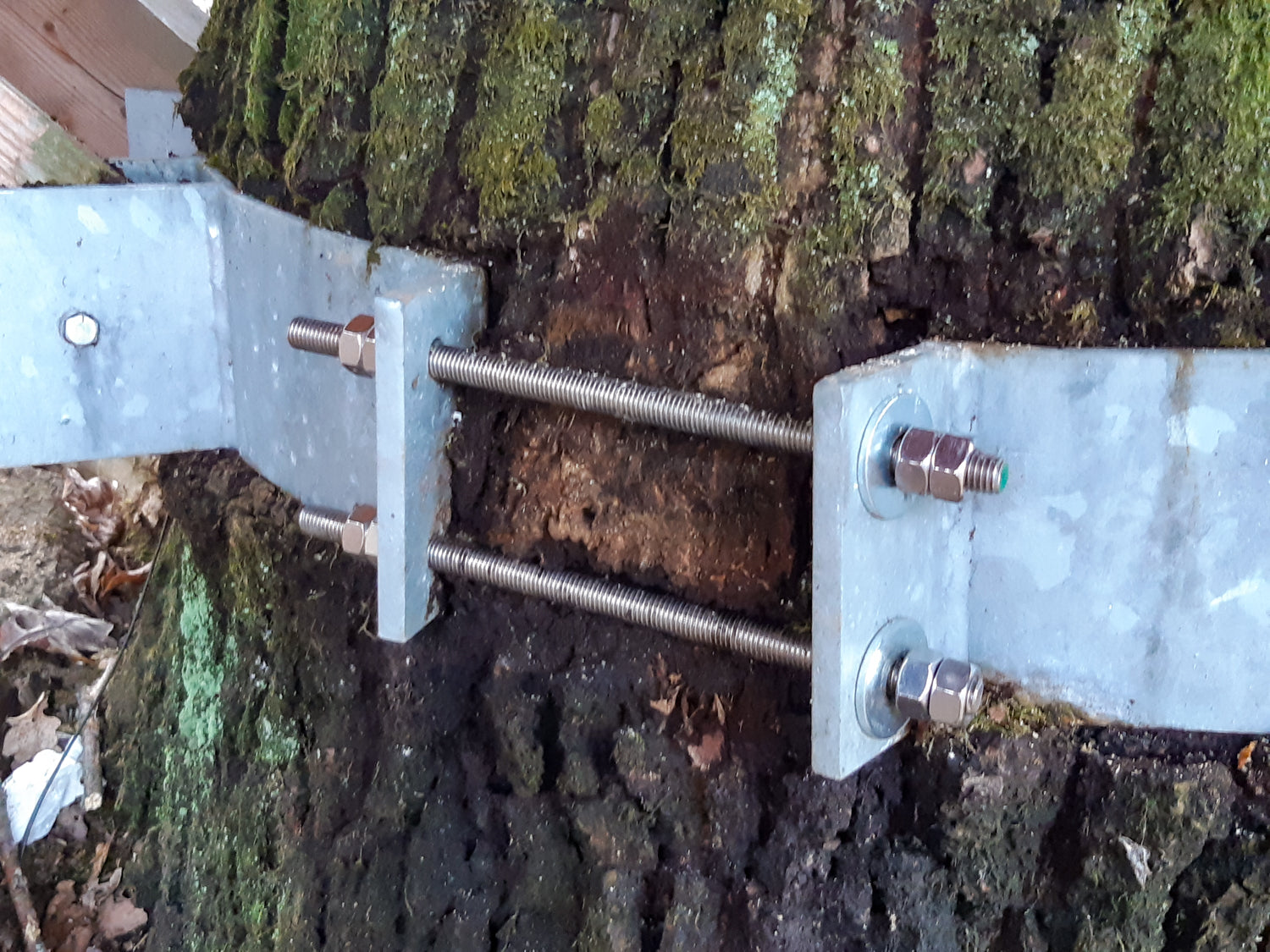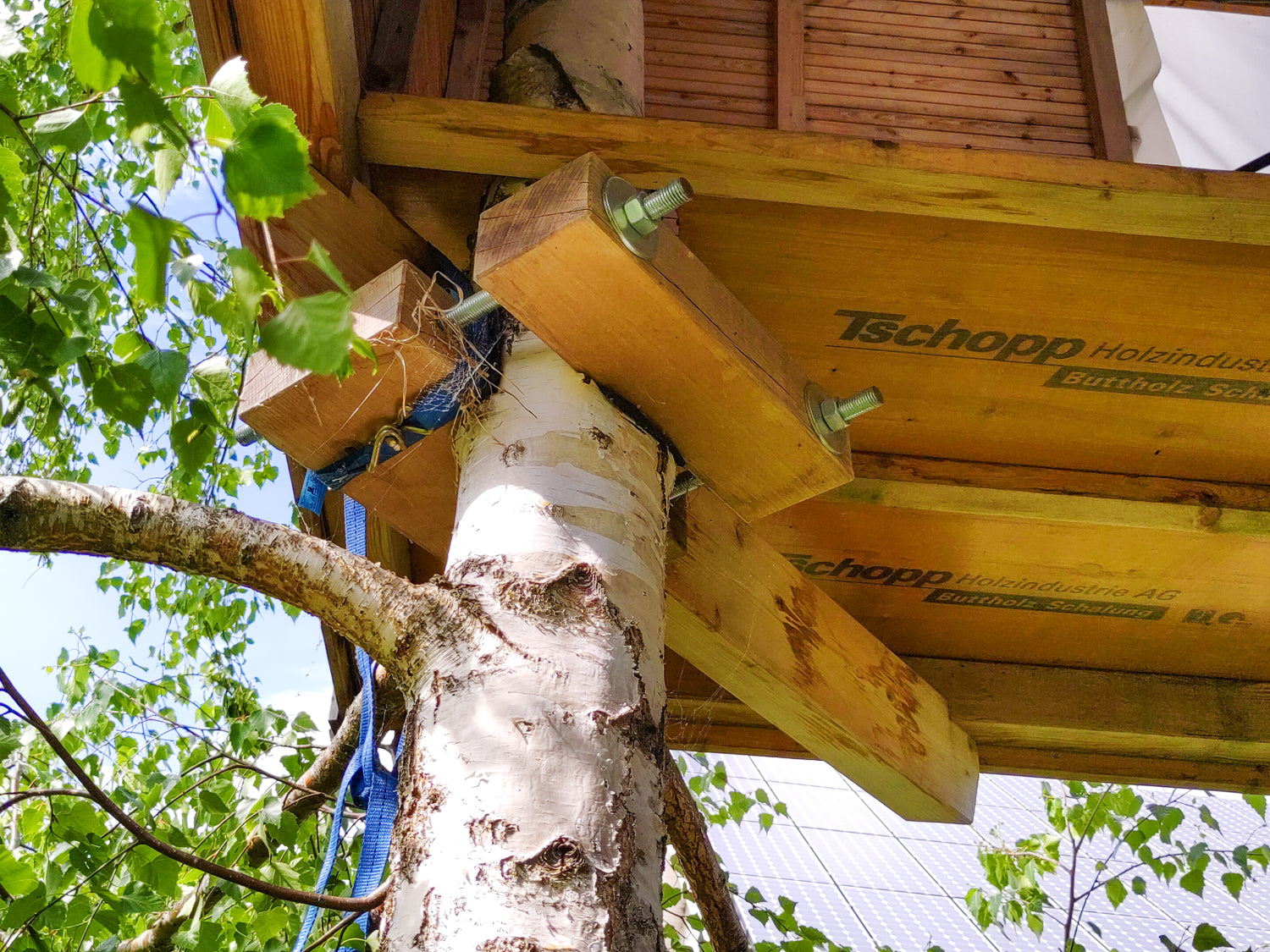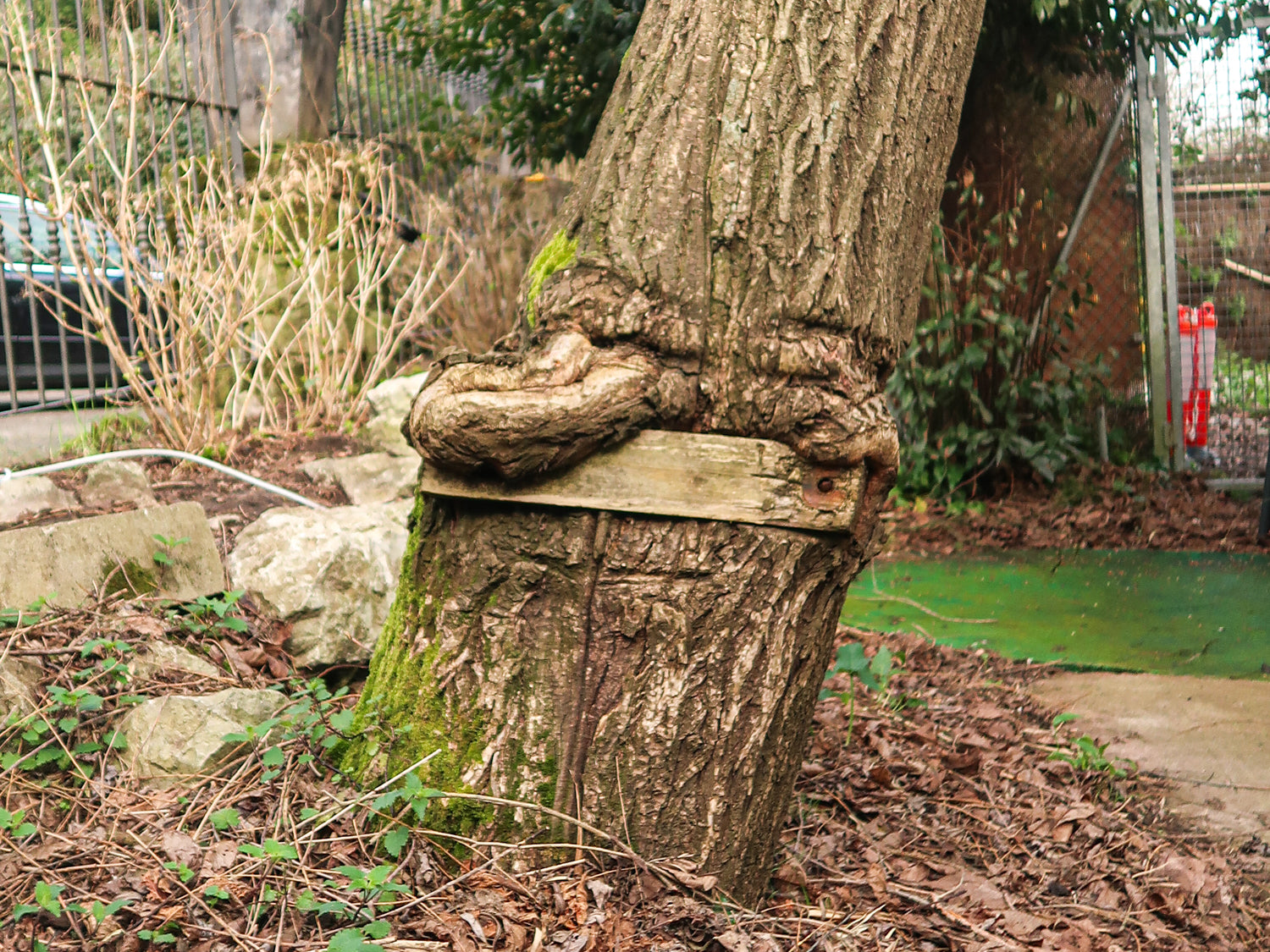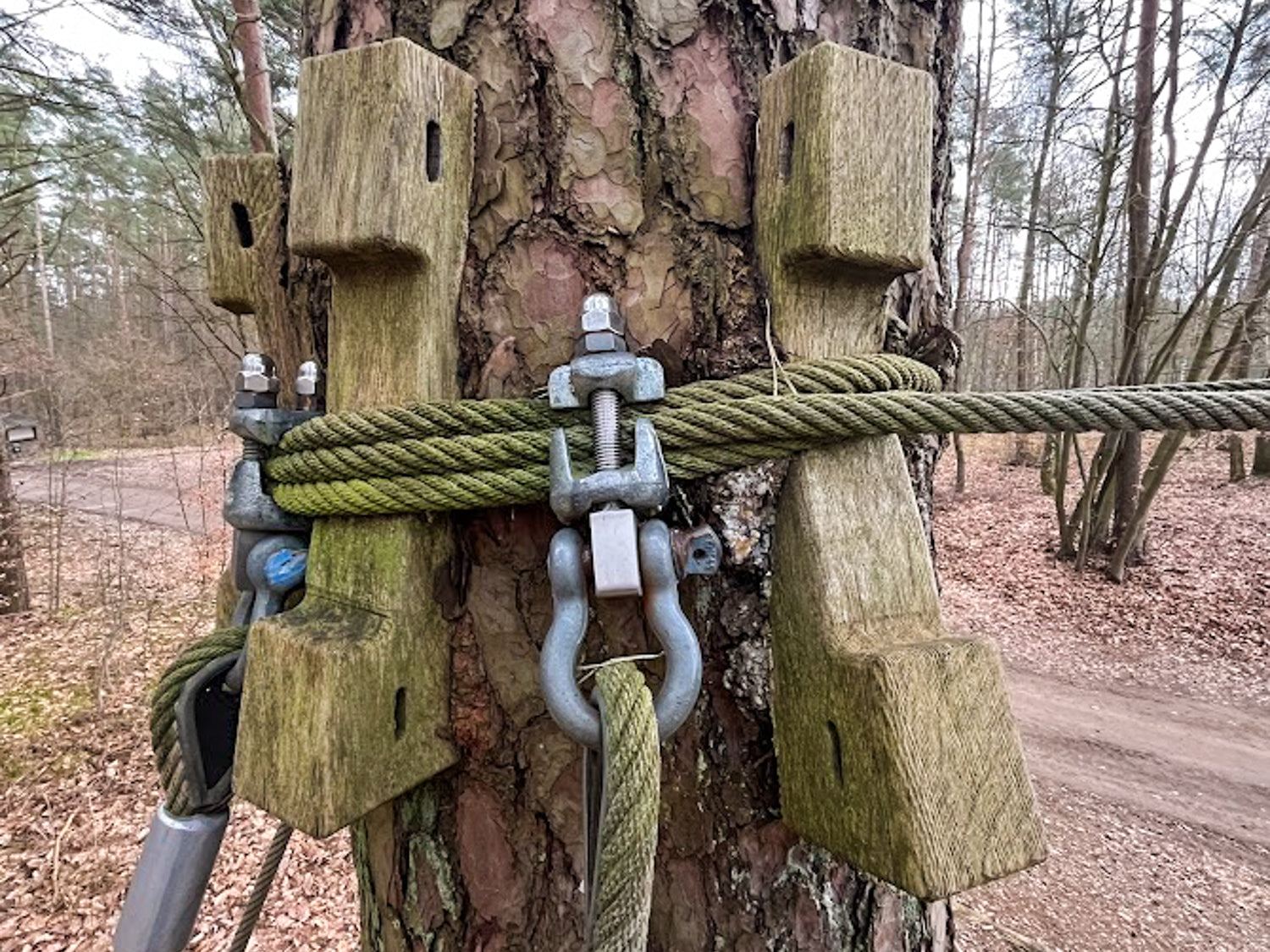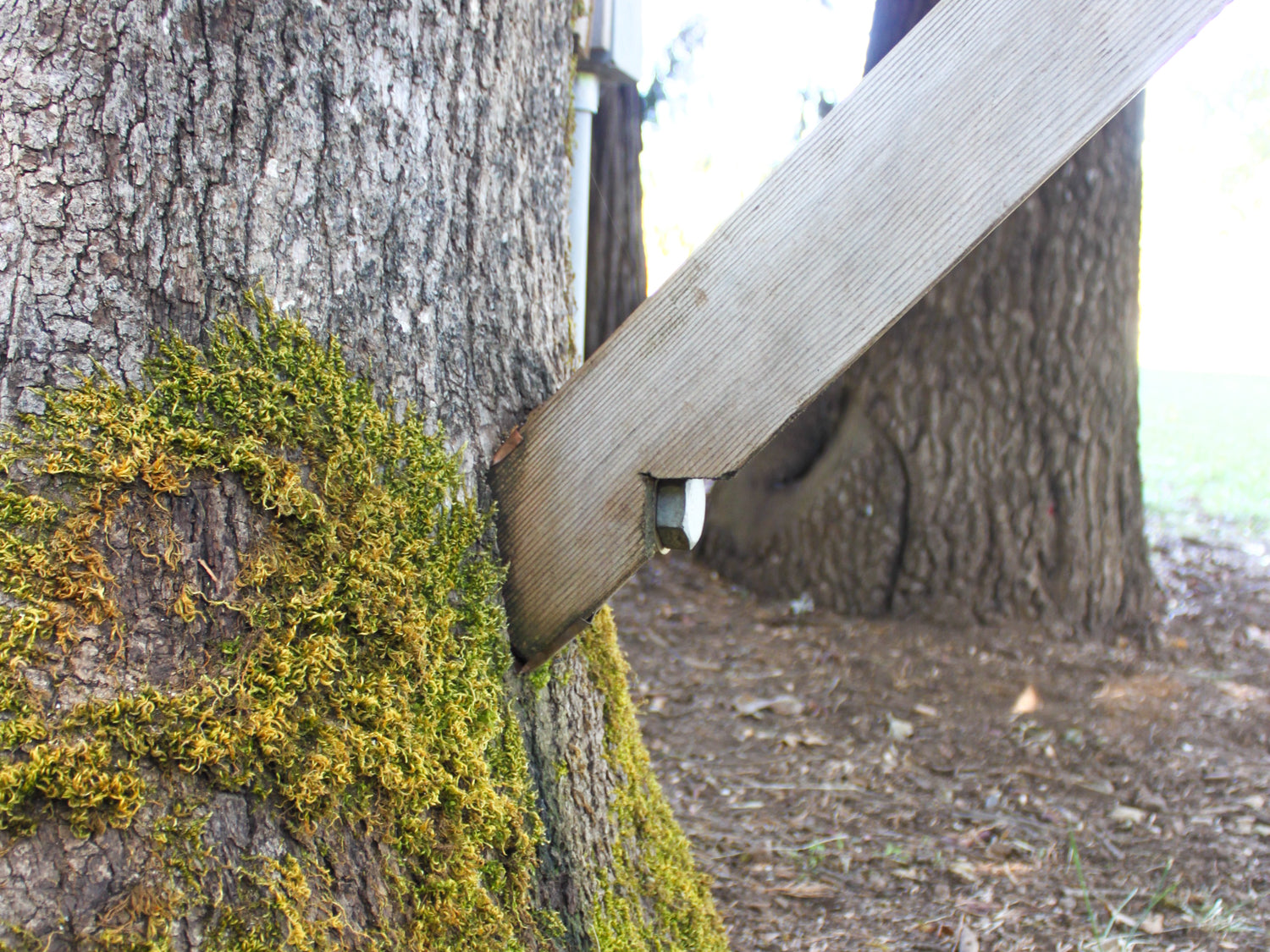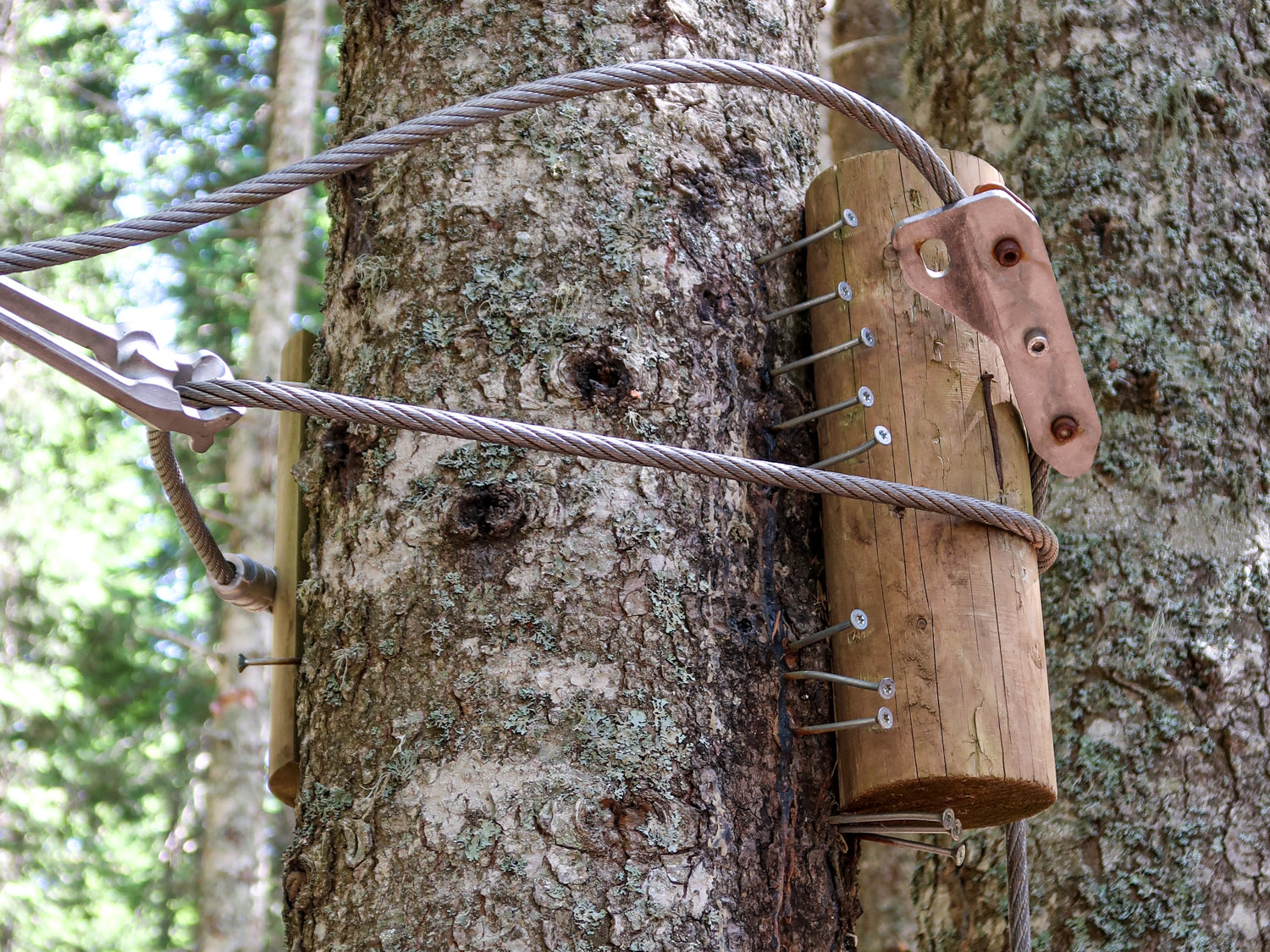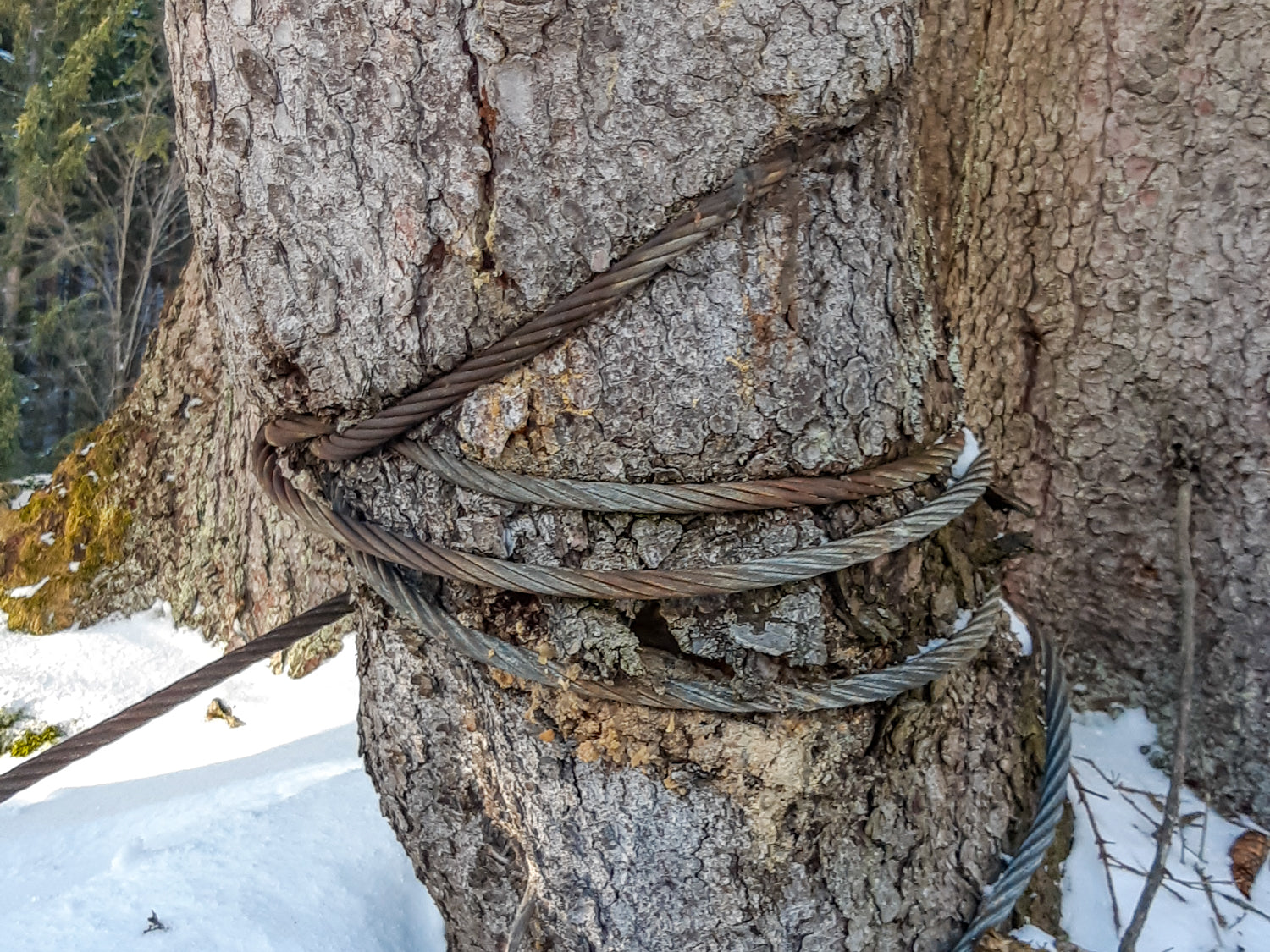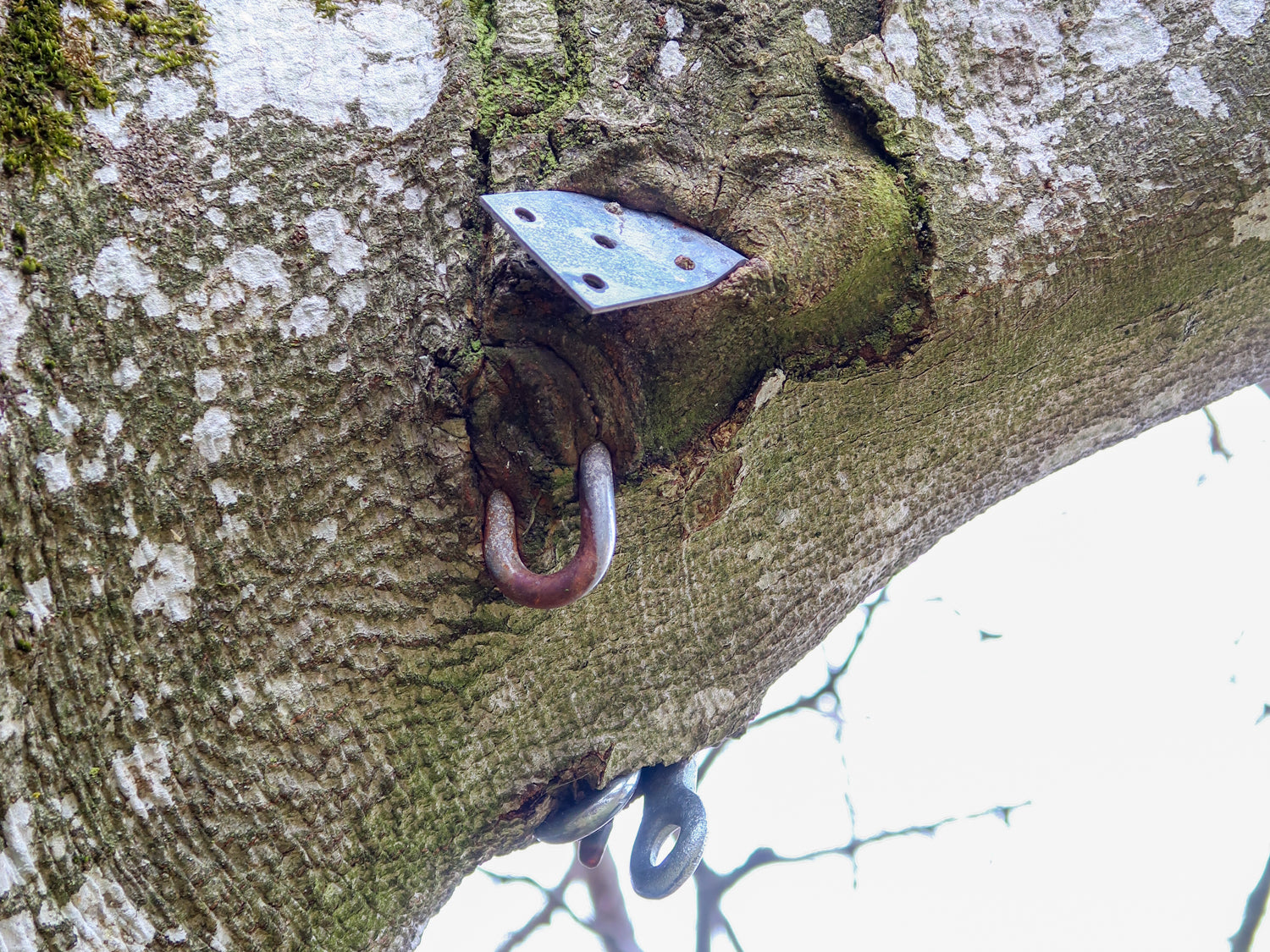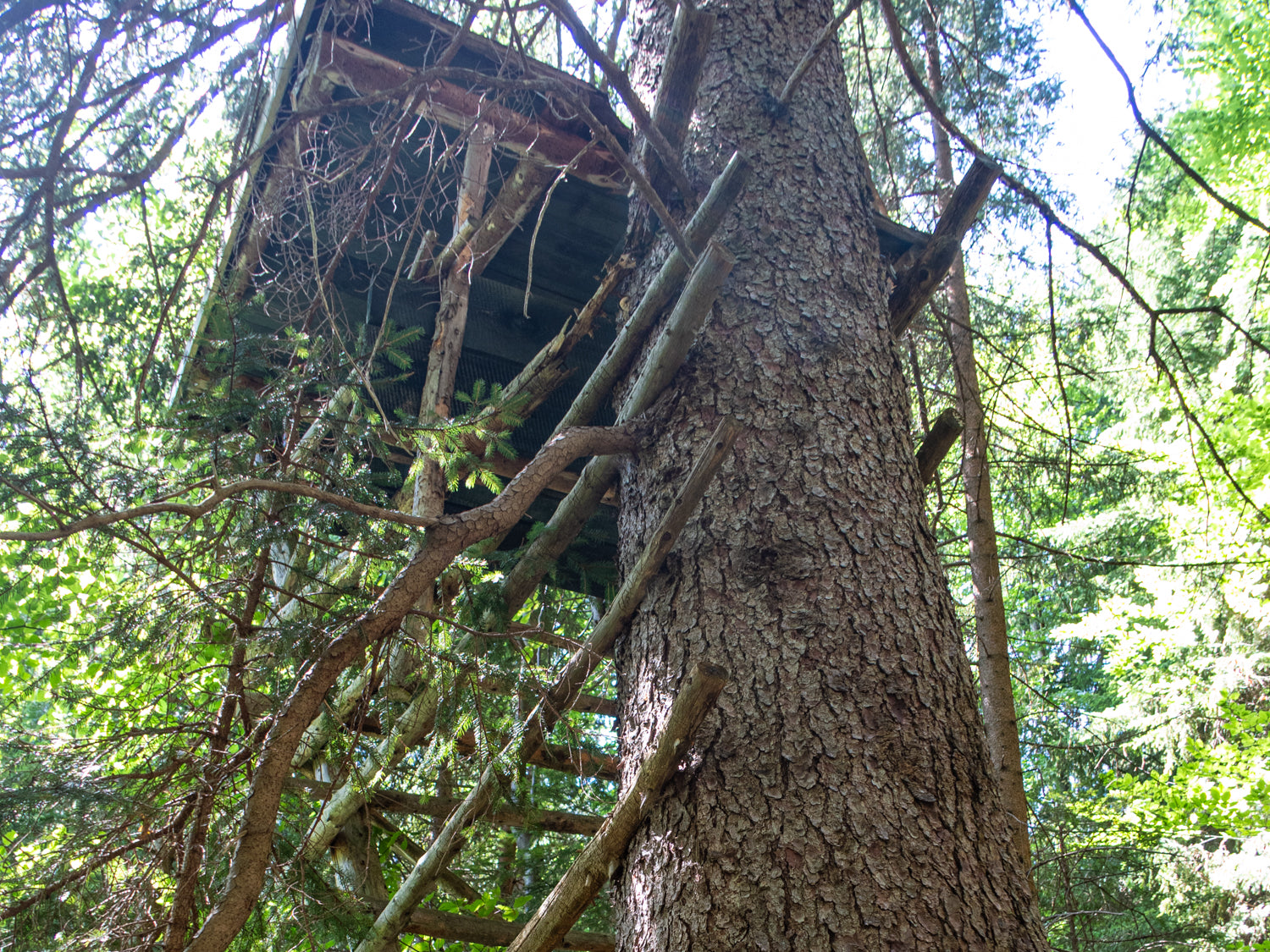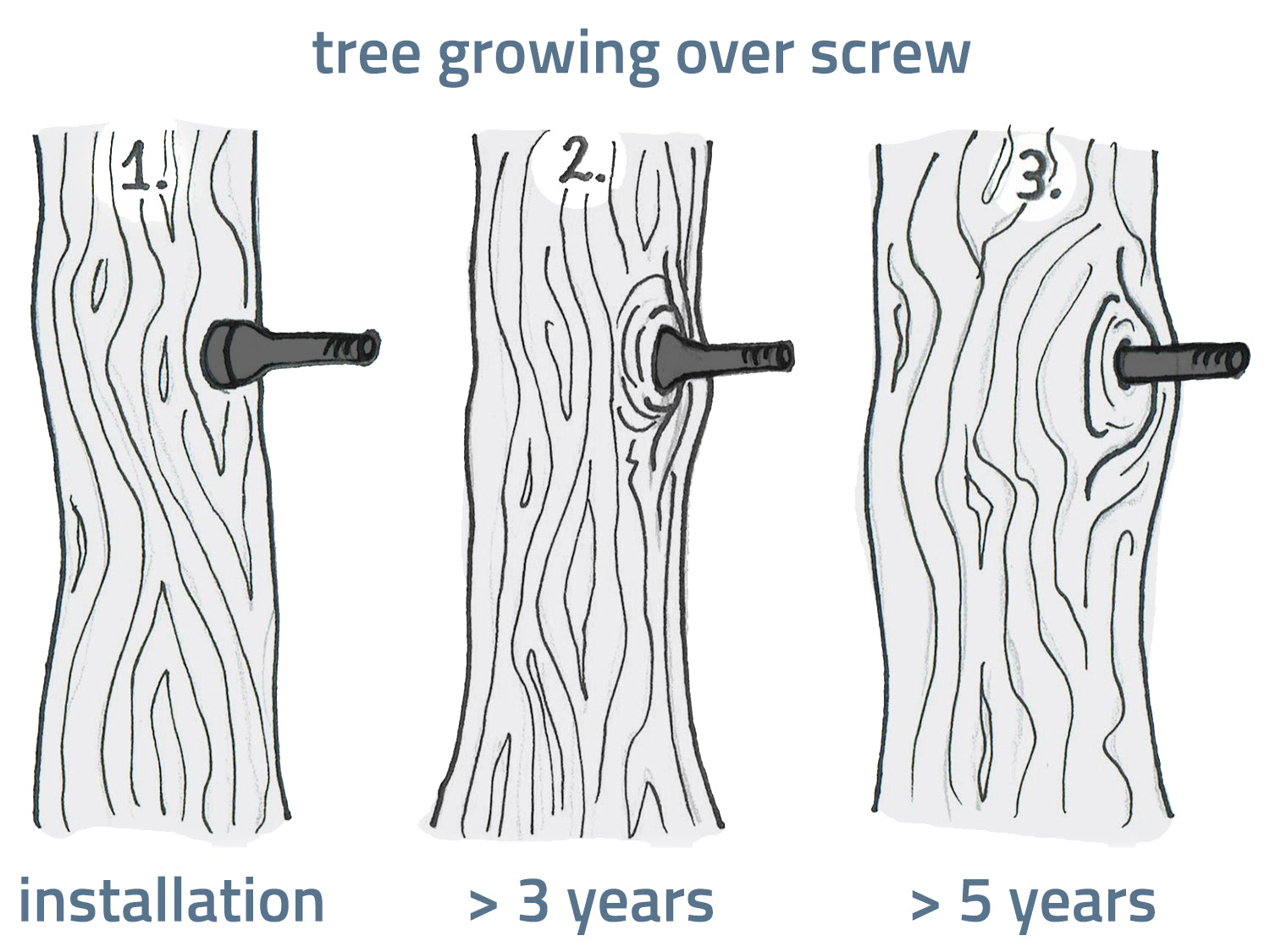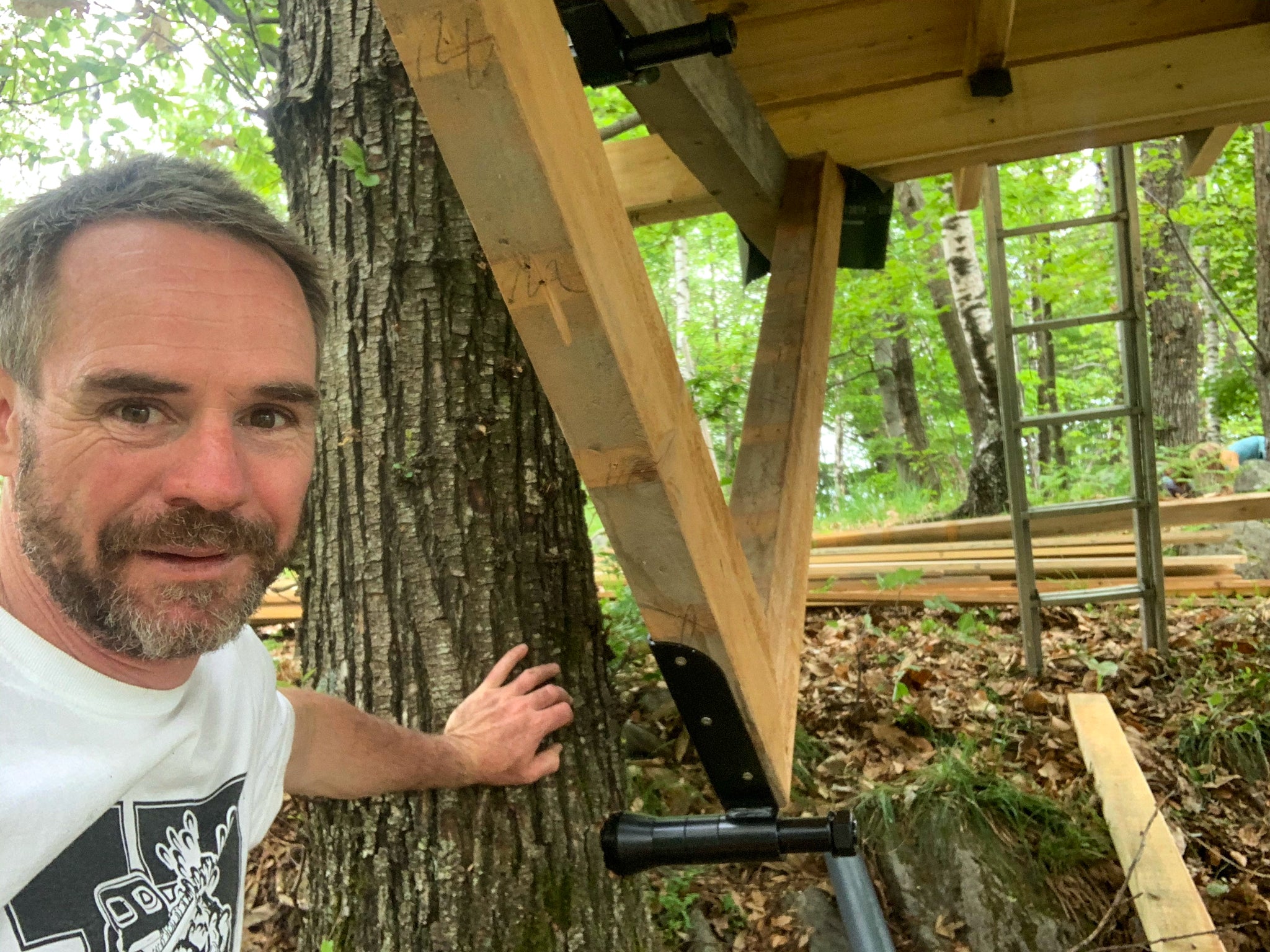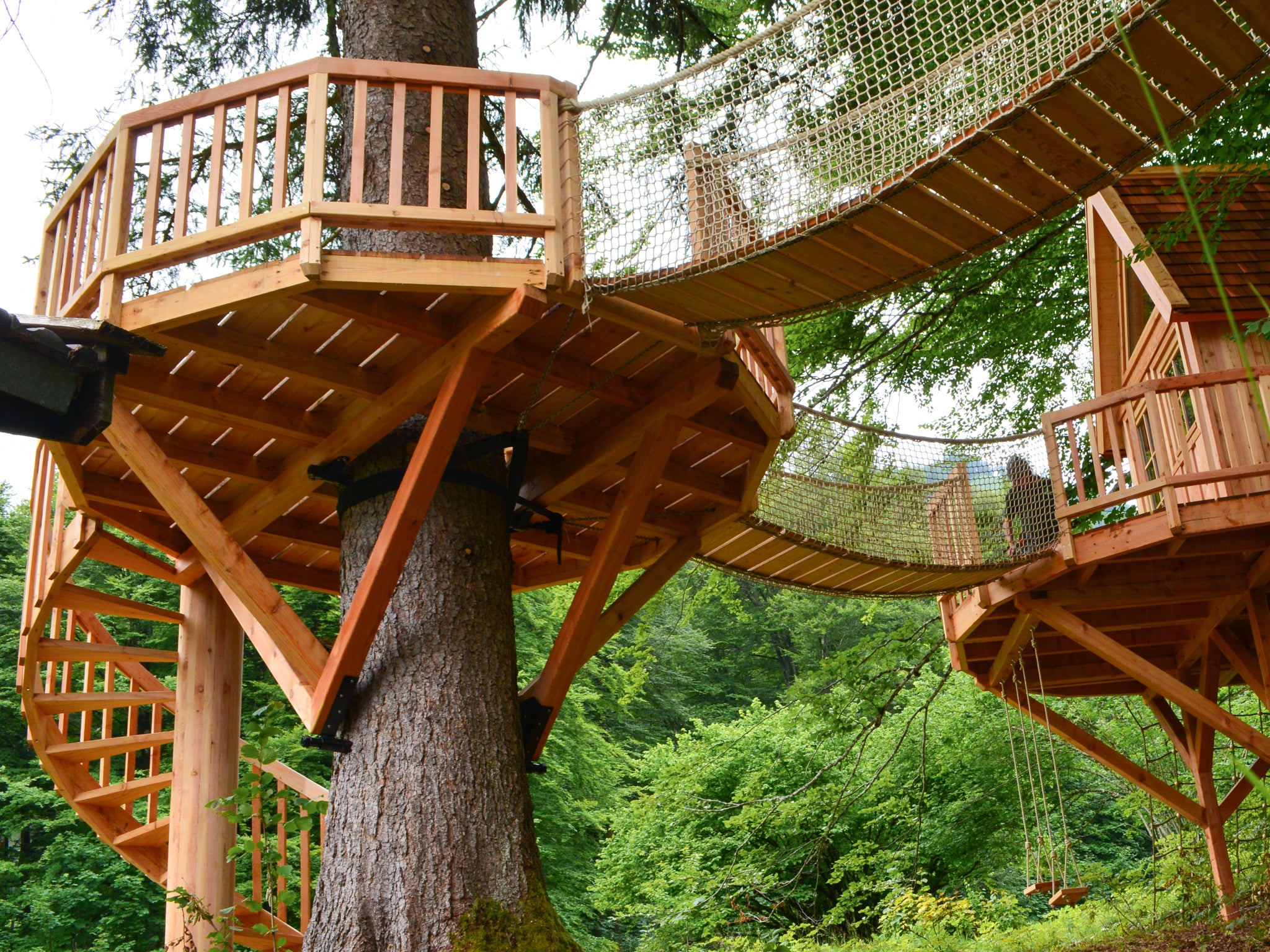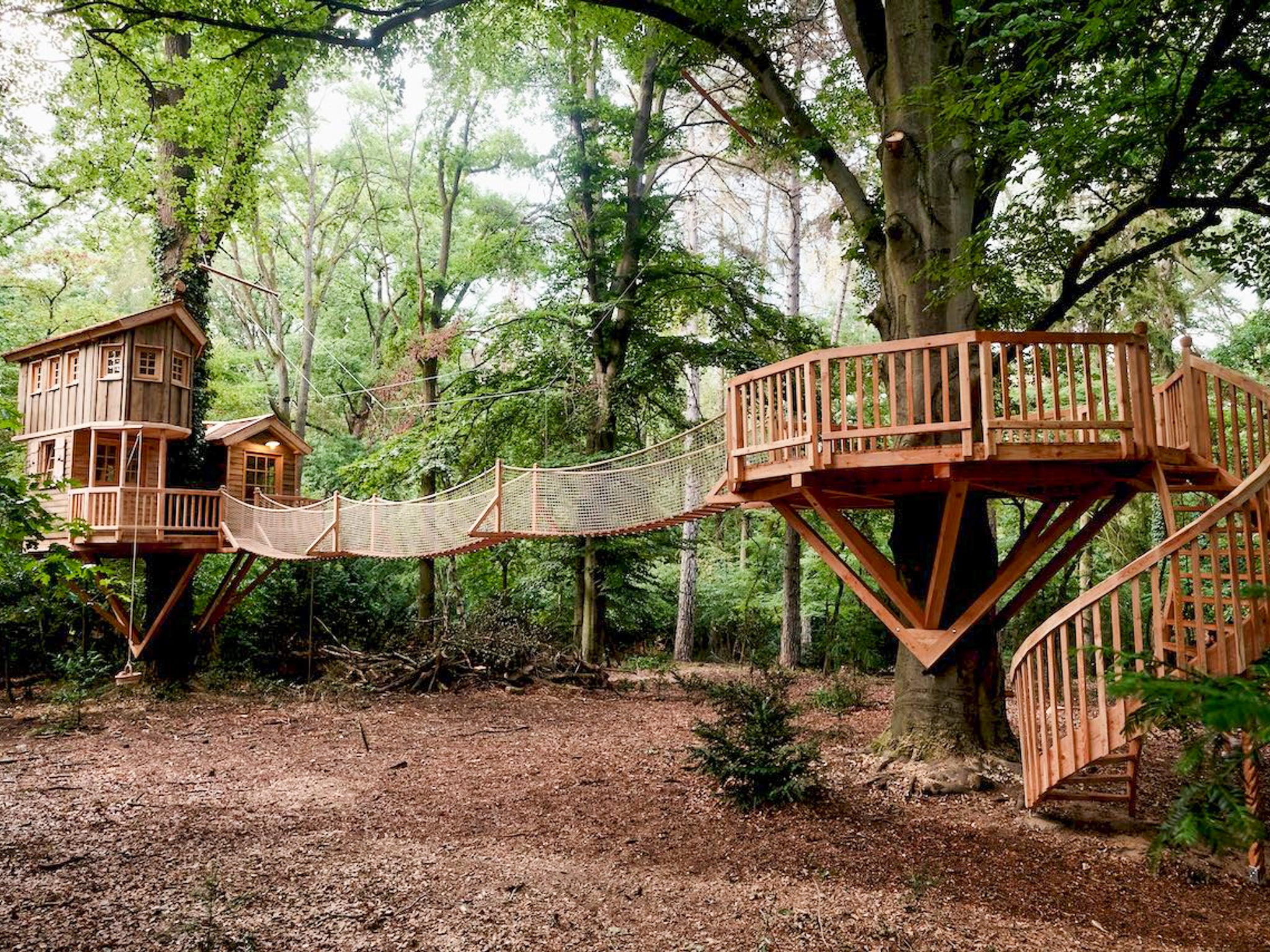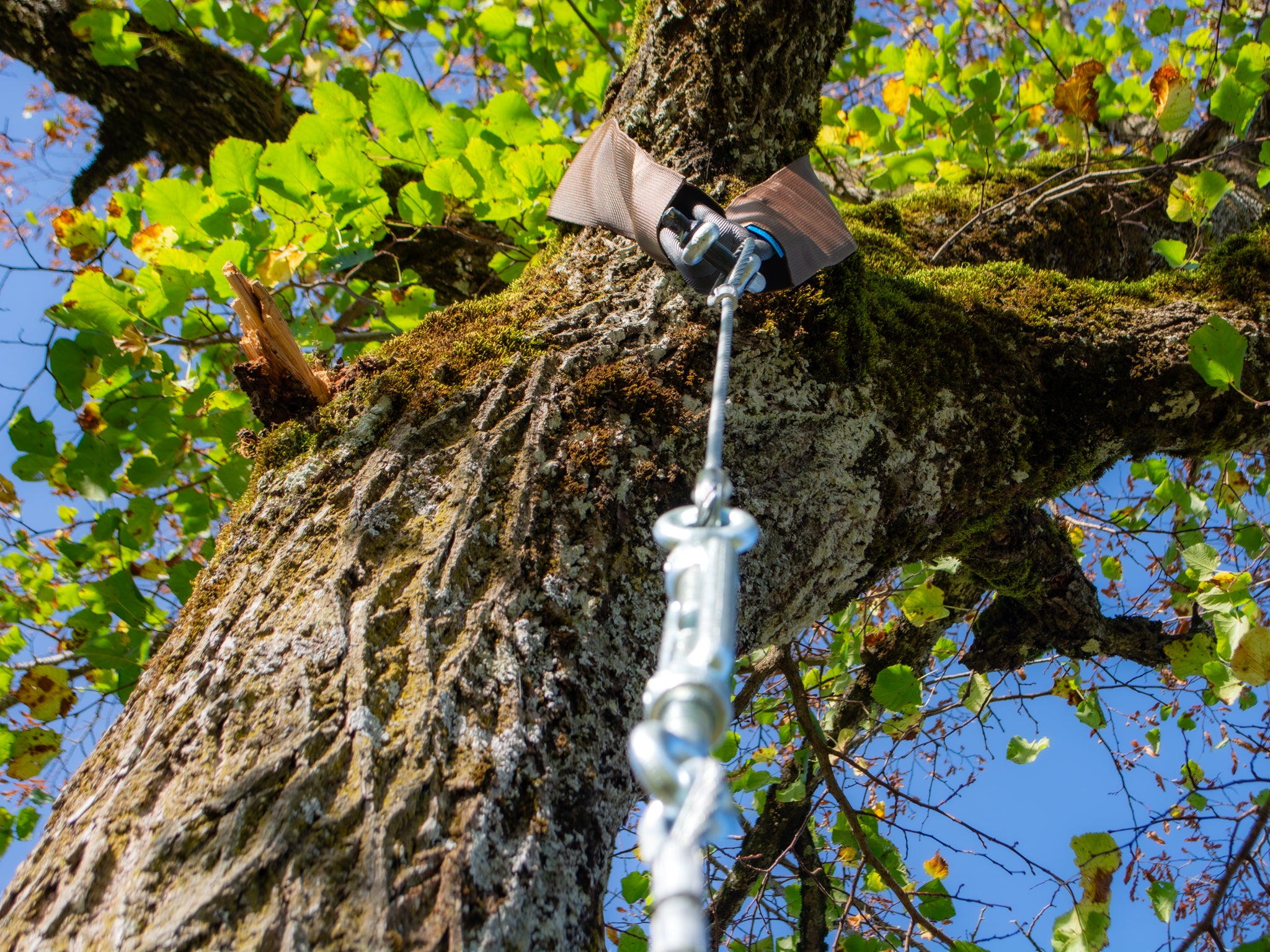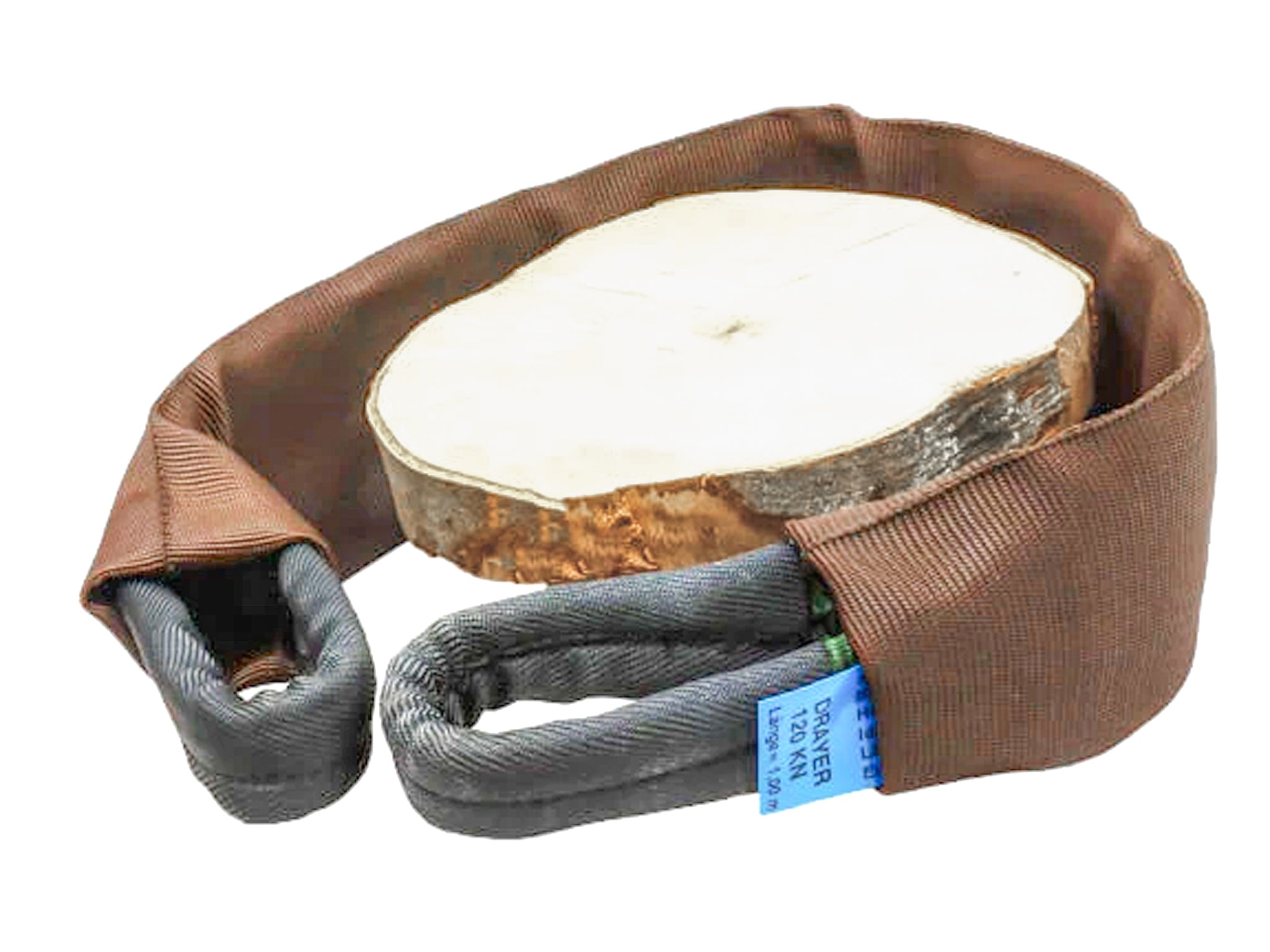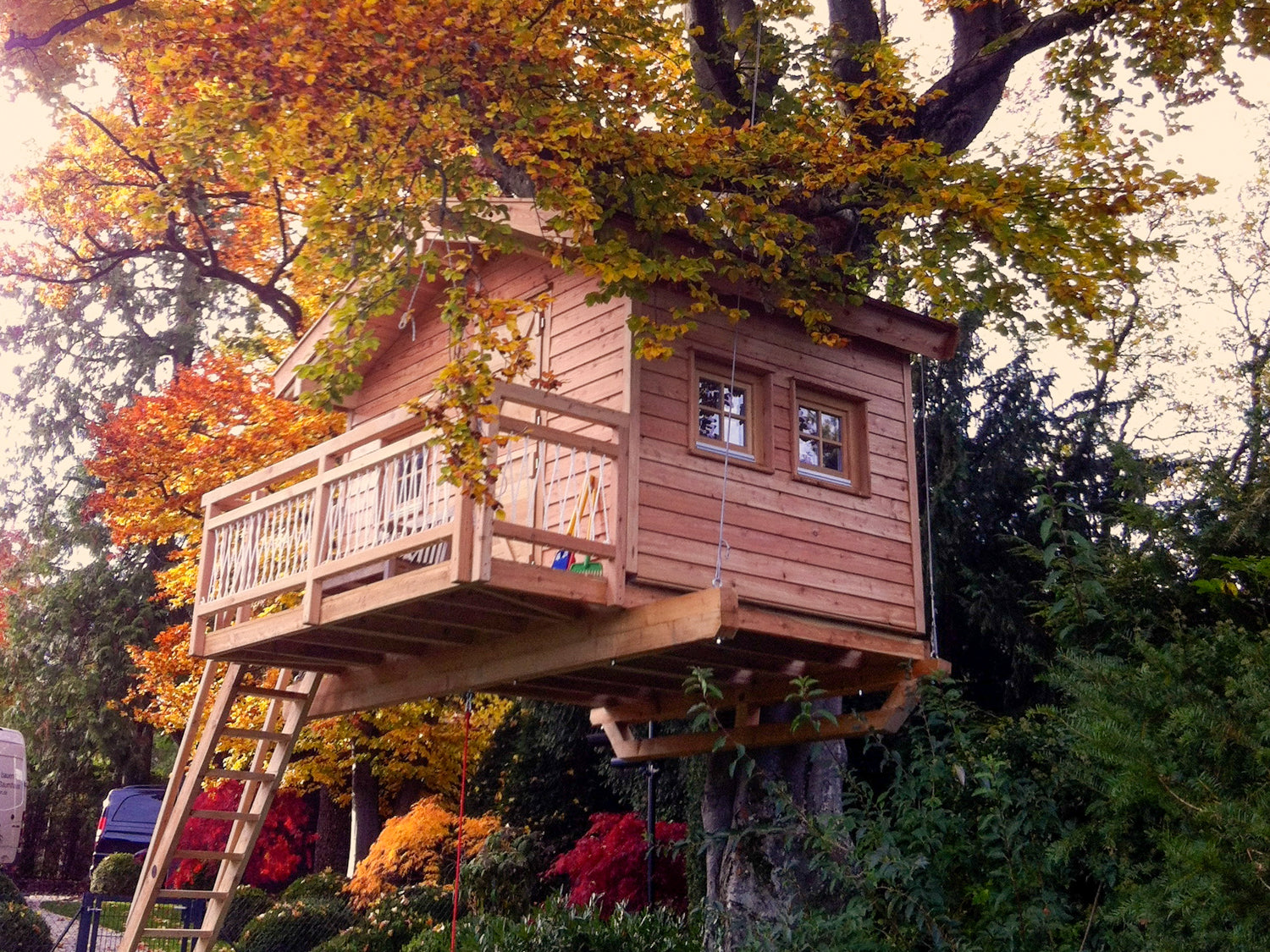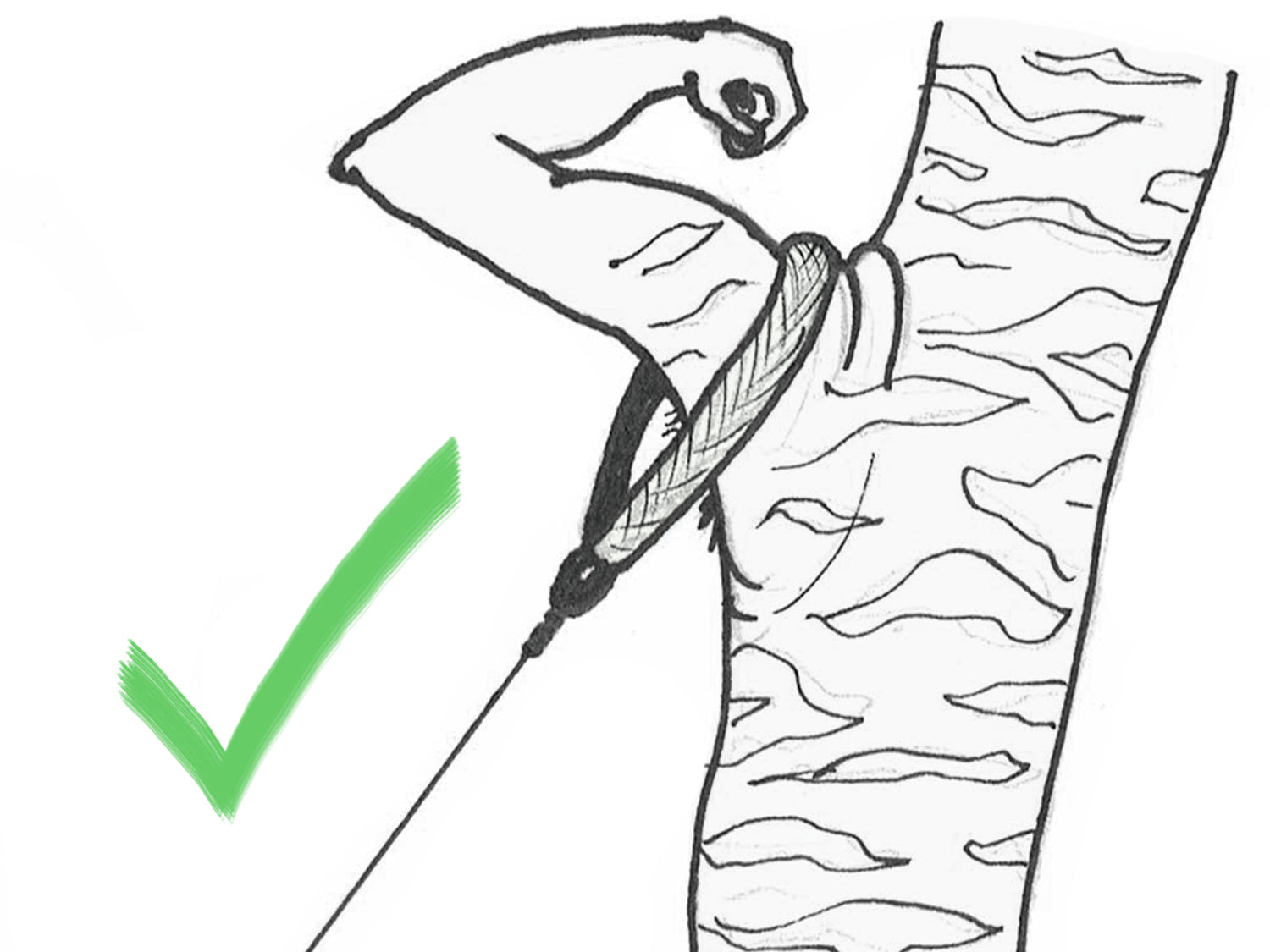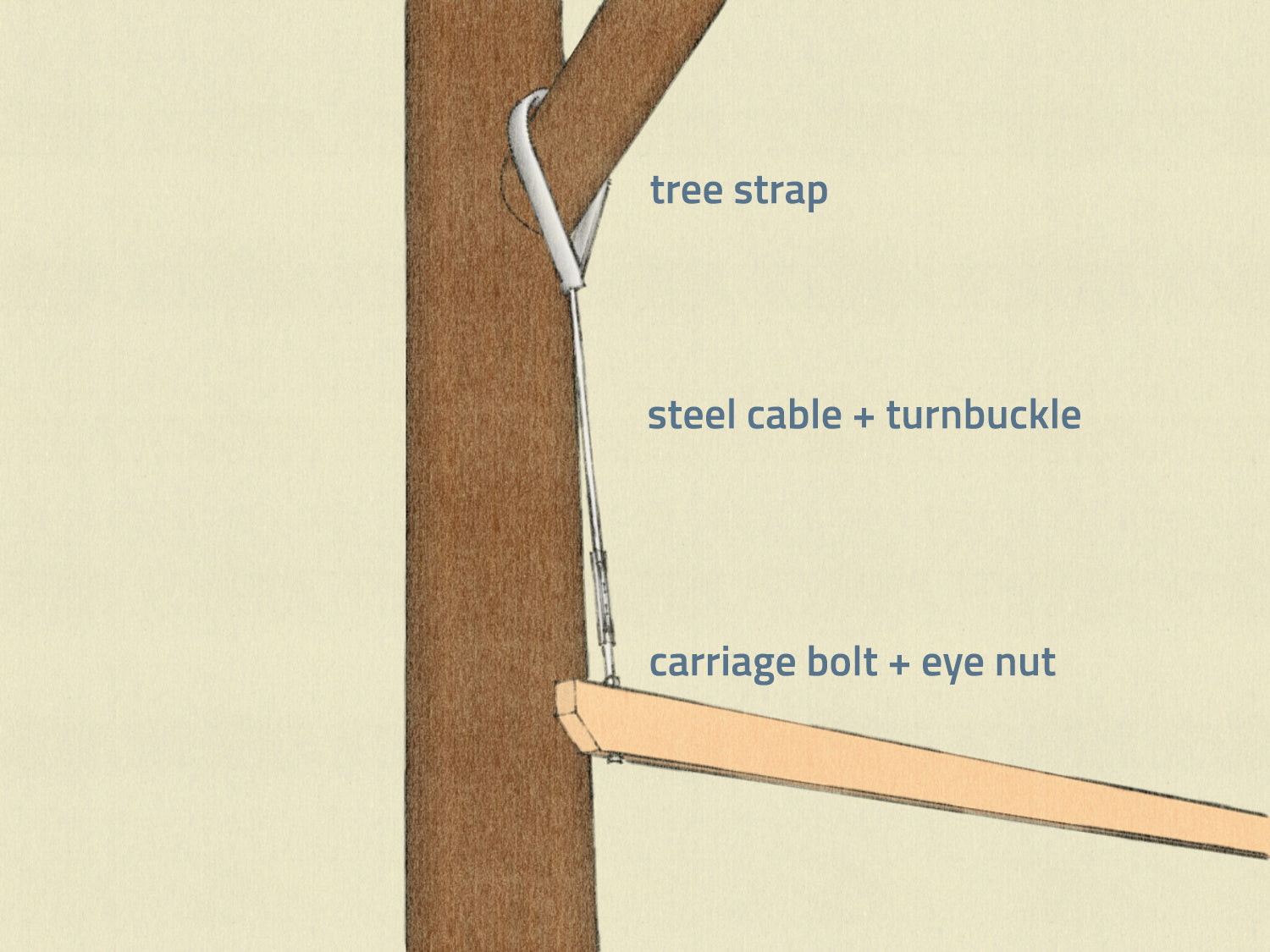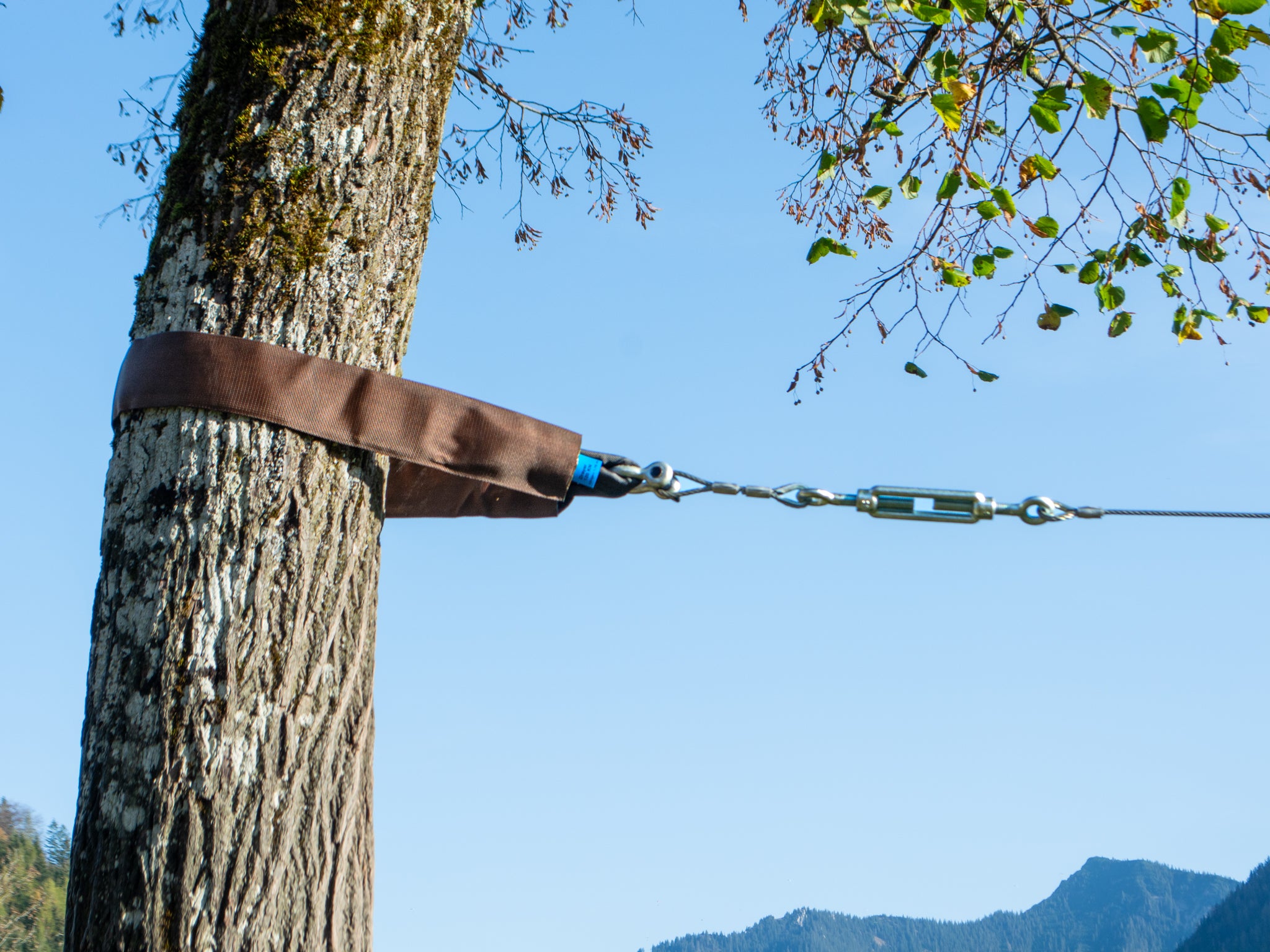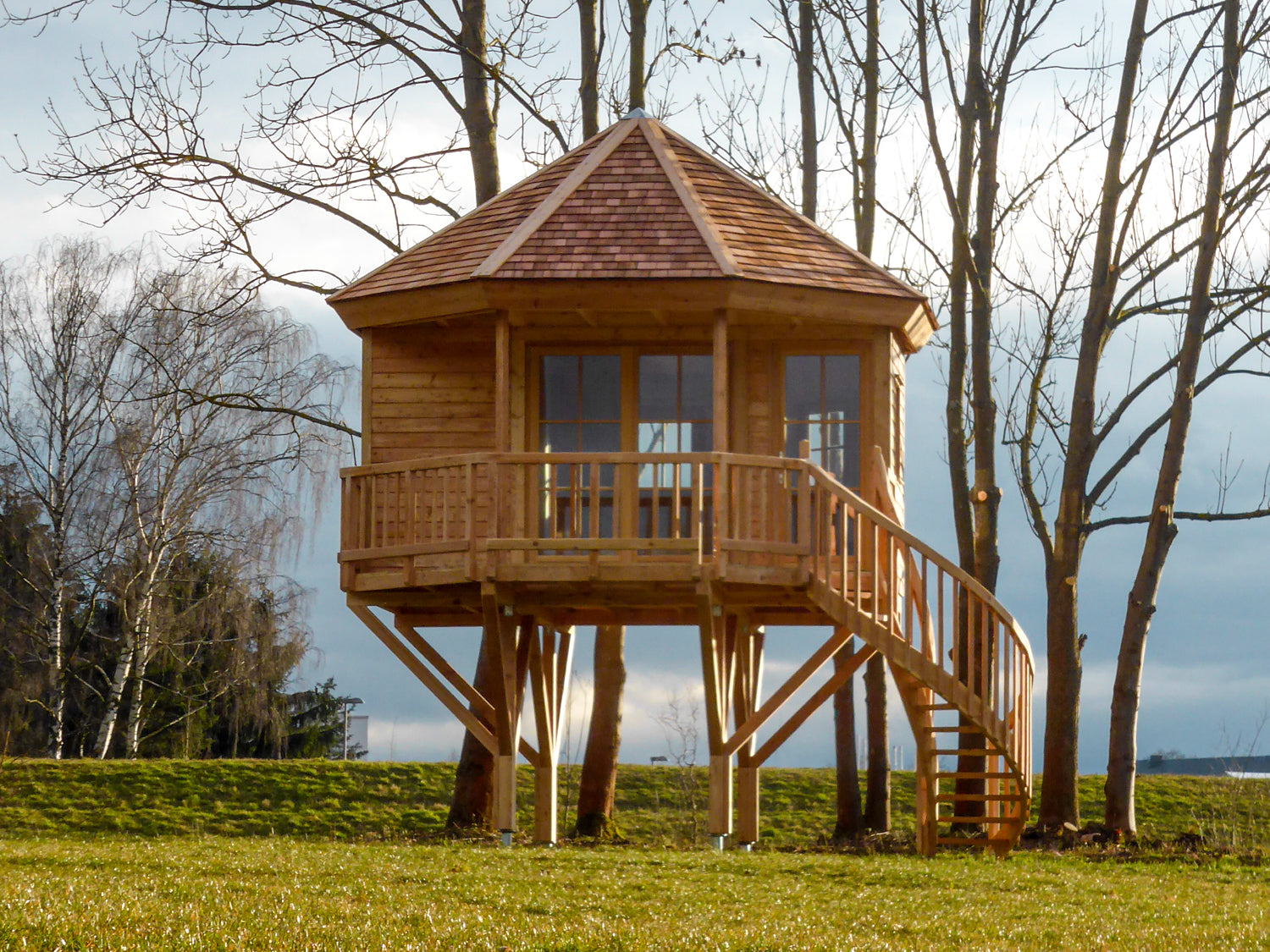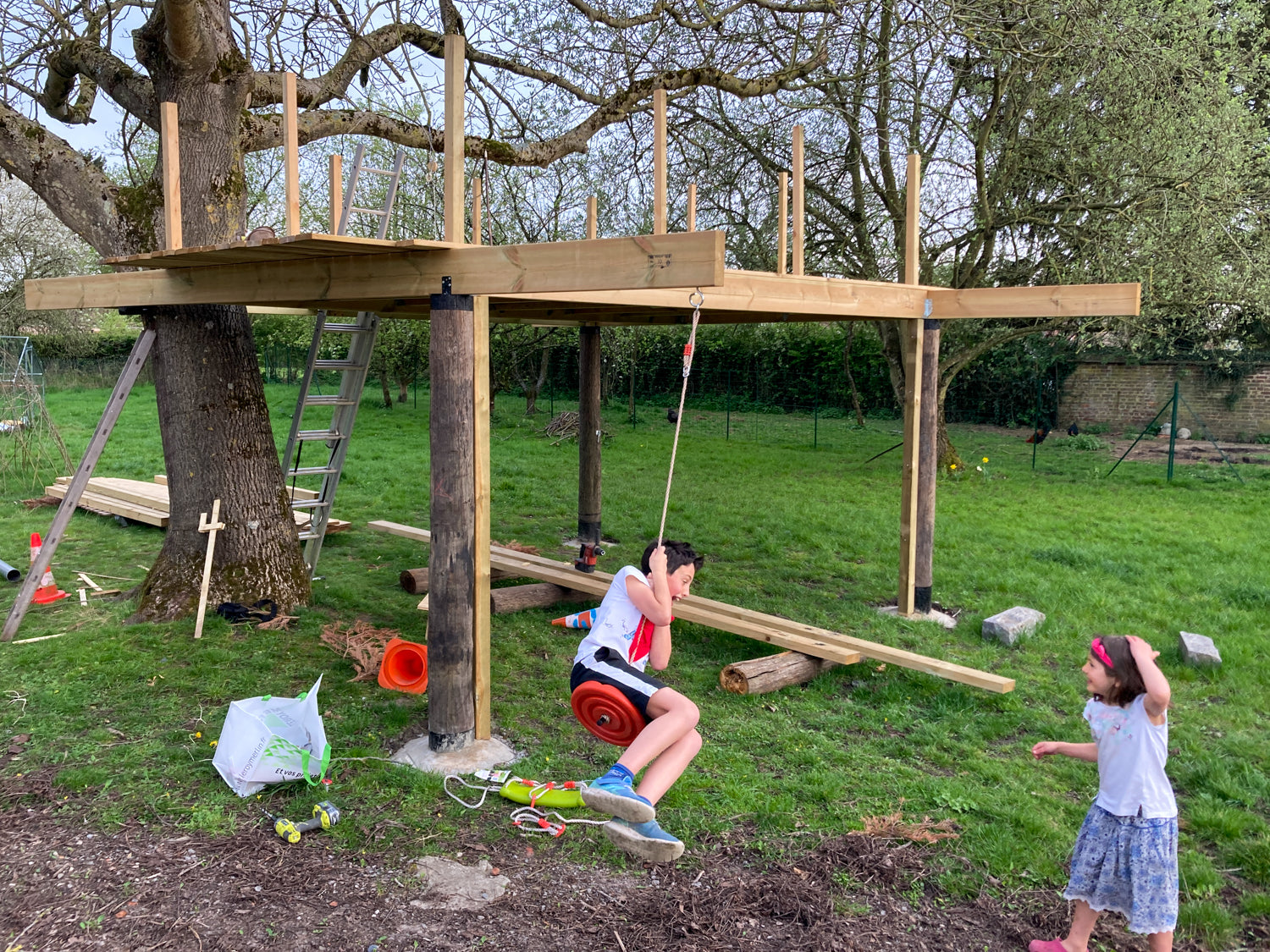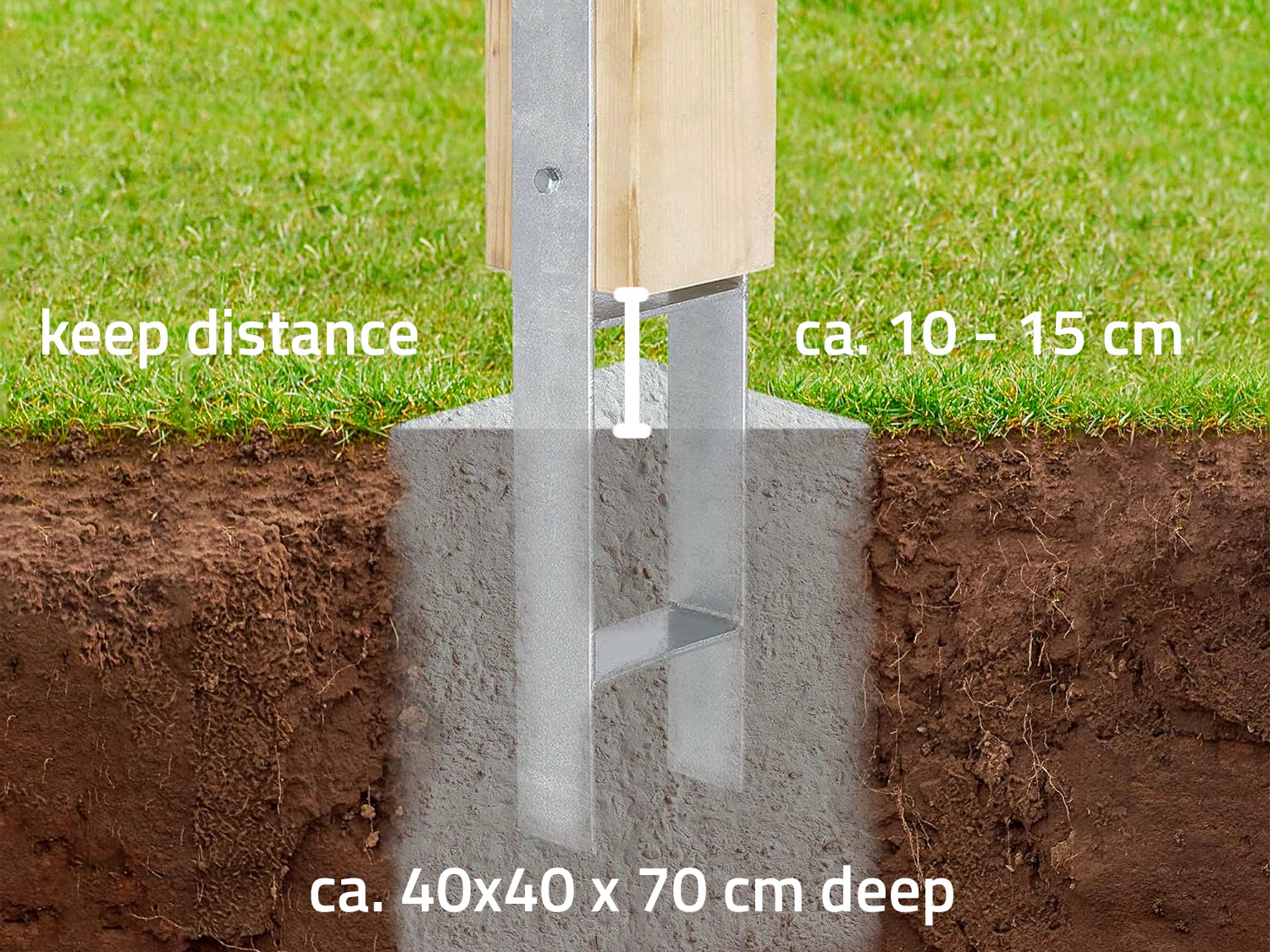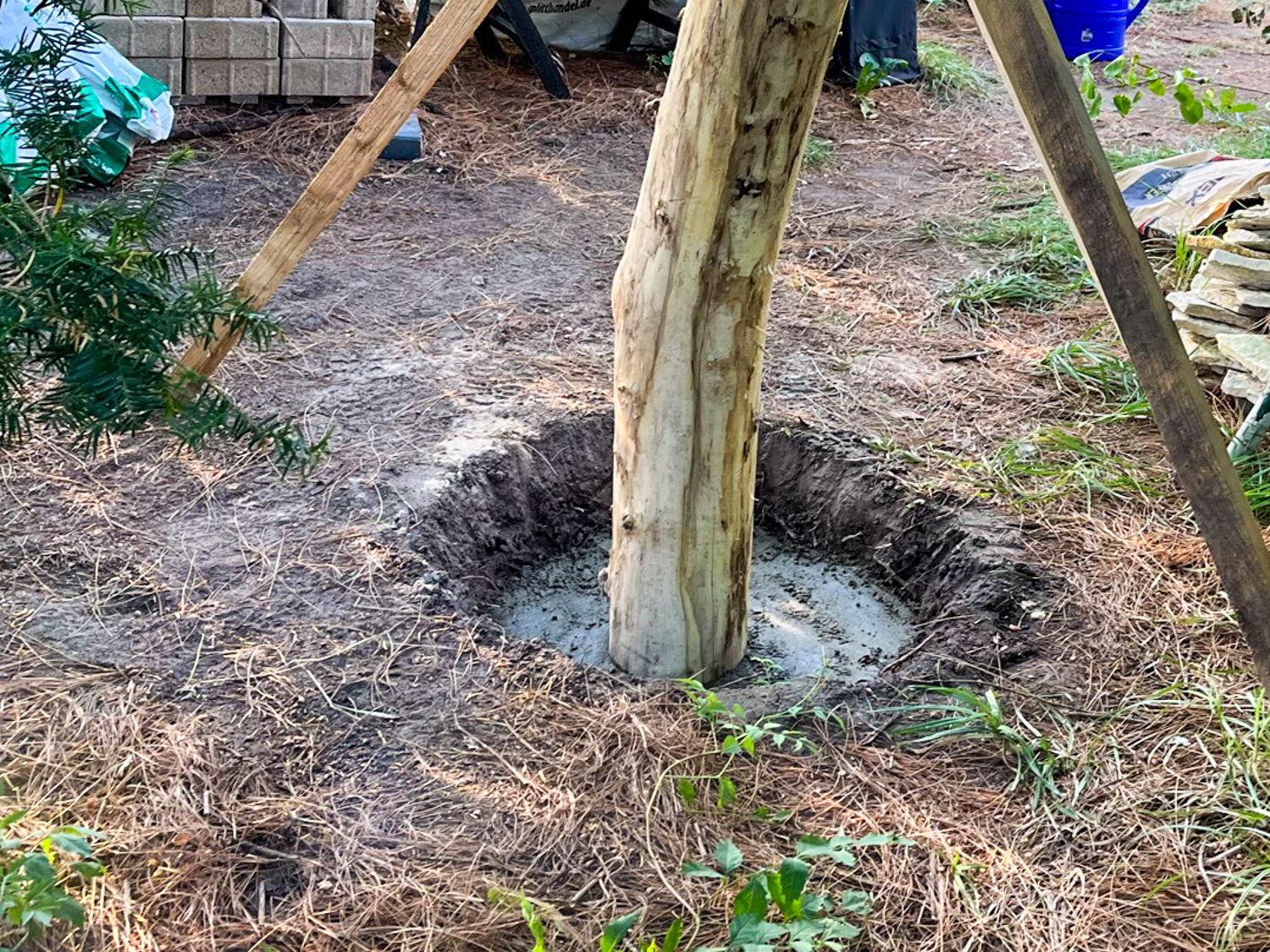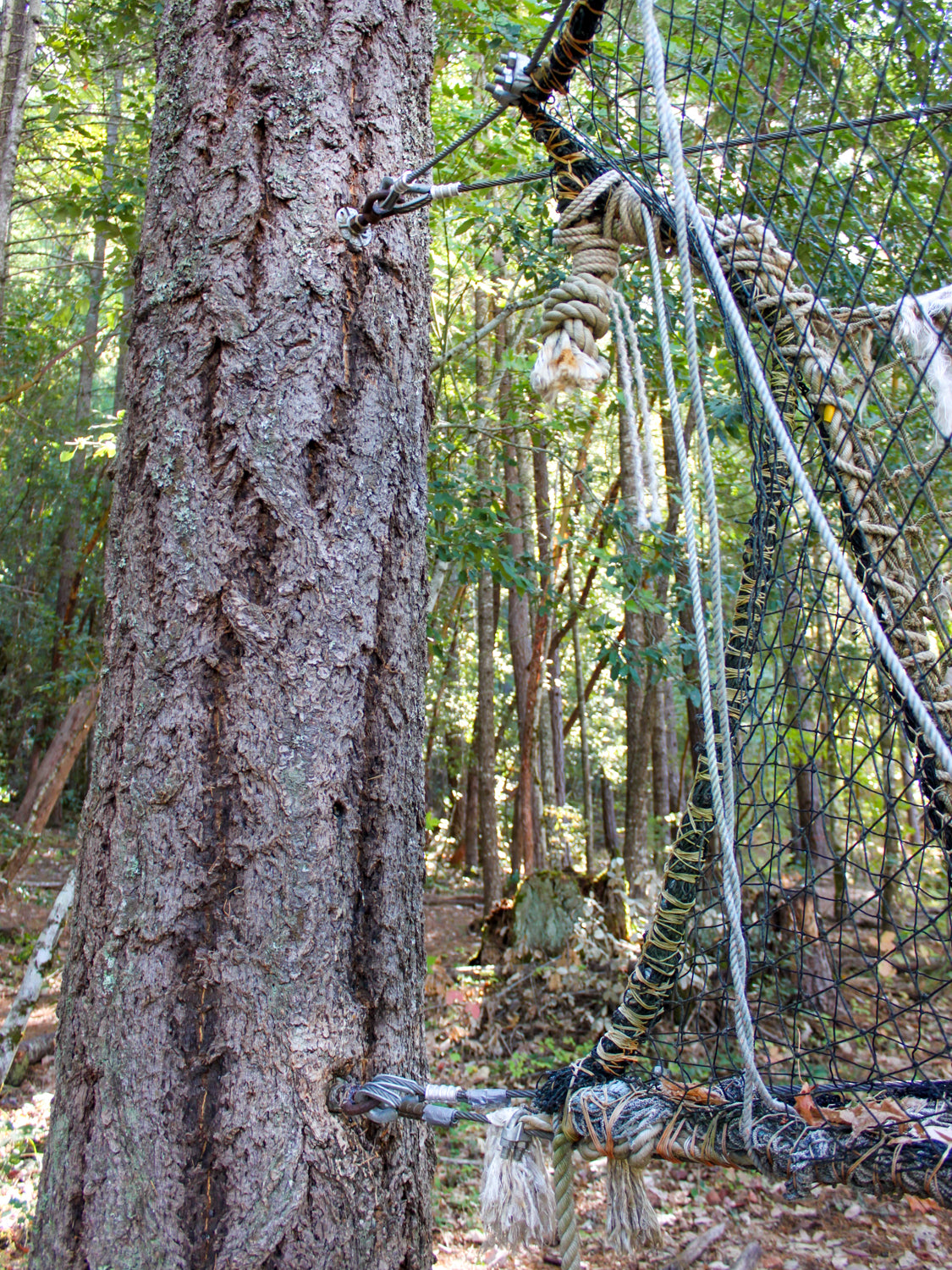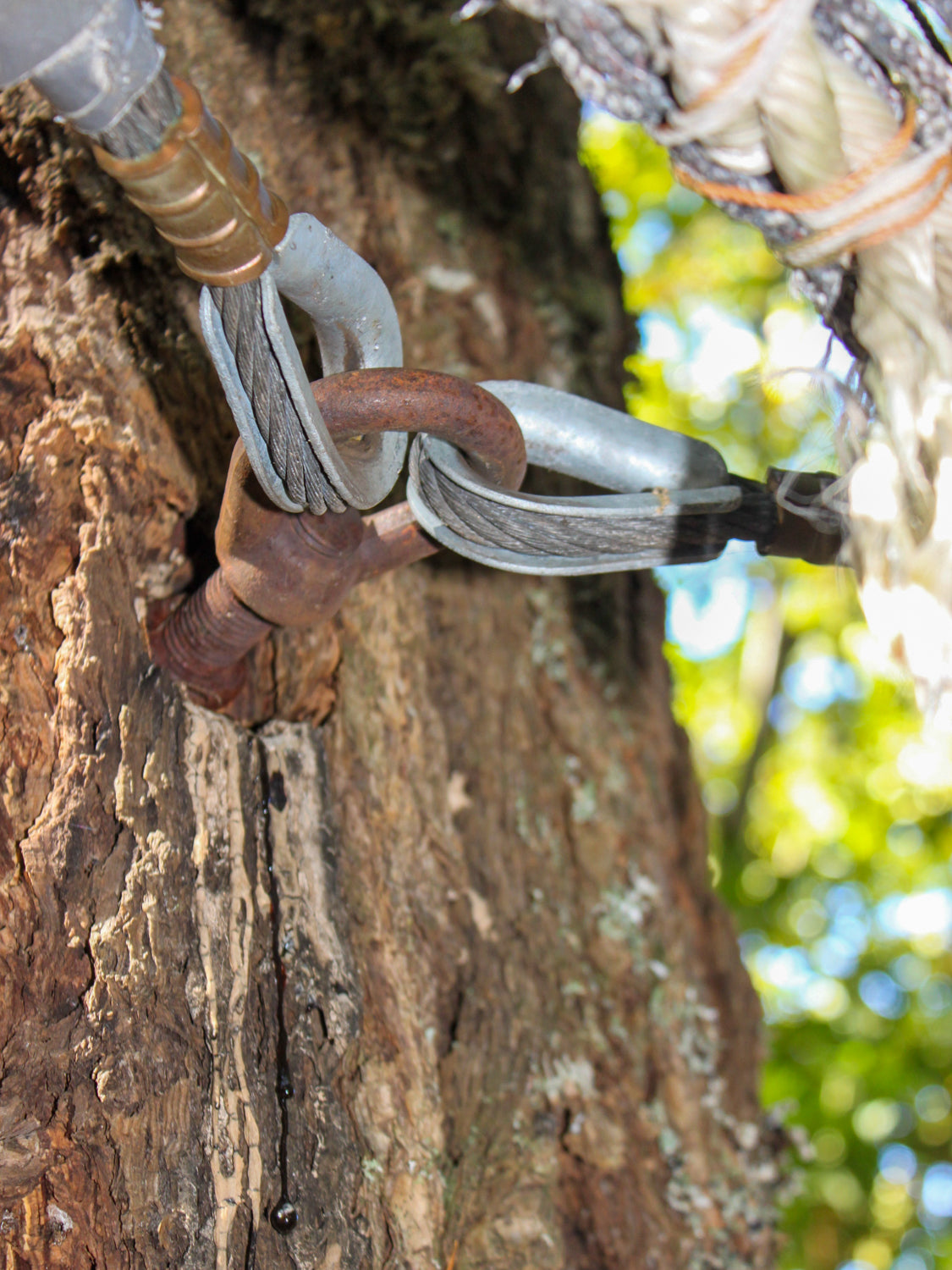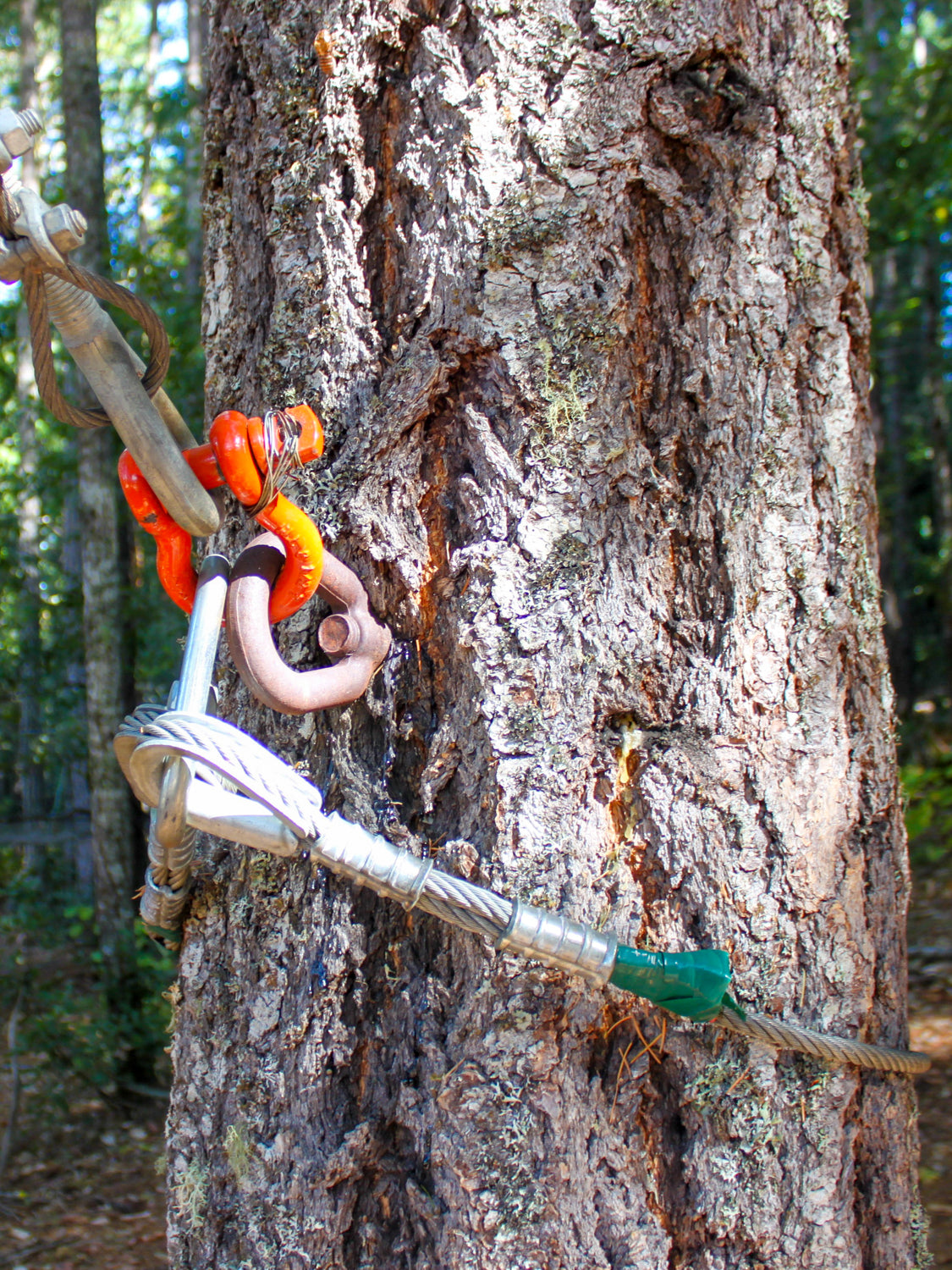Step 7: Treehouse Attachment Methods Compared
How Treehouse-Pro professionals attach their platforms to trees:
✔ Tree Bolts are the most tree-friendly and secure fastenings for heavy platforms in the long term (> 3 years)
✔ Stilt legs and Tree Support Slings are also a good solution
✔ Caution: The tree trunk needs space for natural growth in thickness!
❌ Do not use: Direct, clamping fastenings with wooden beams or steel rings
❌ Do not use: threaded rods and normal wood screws from DIY stores
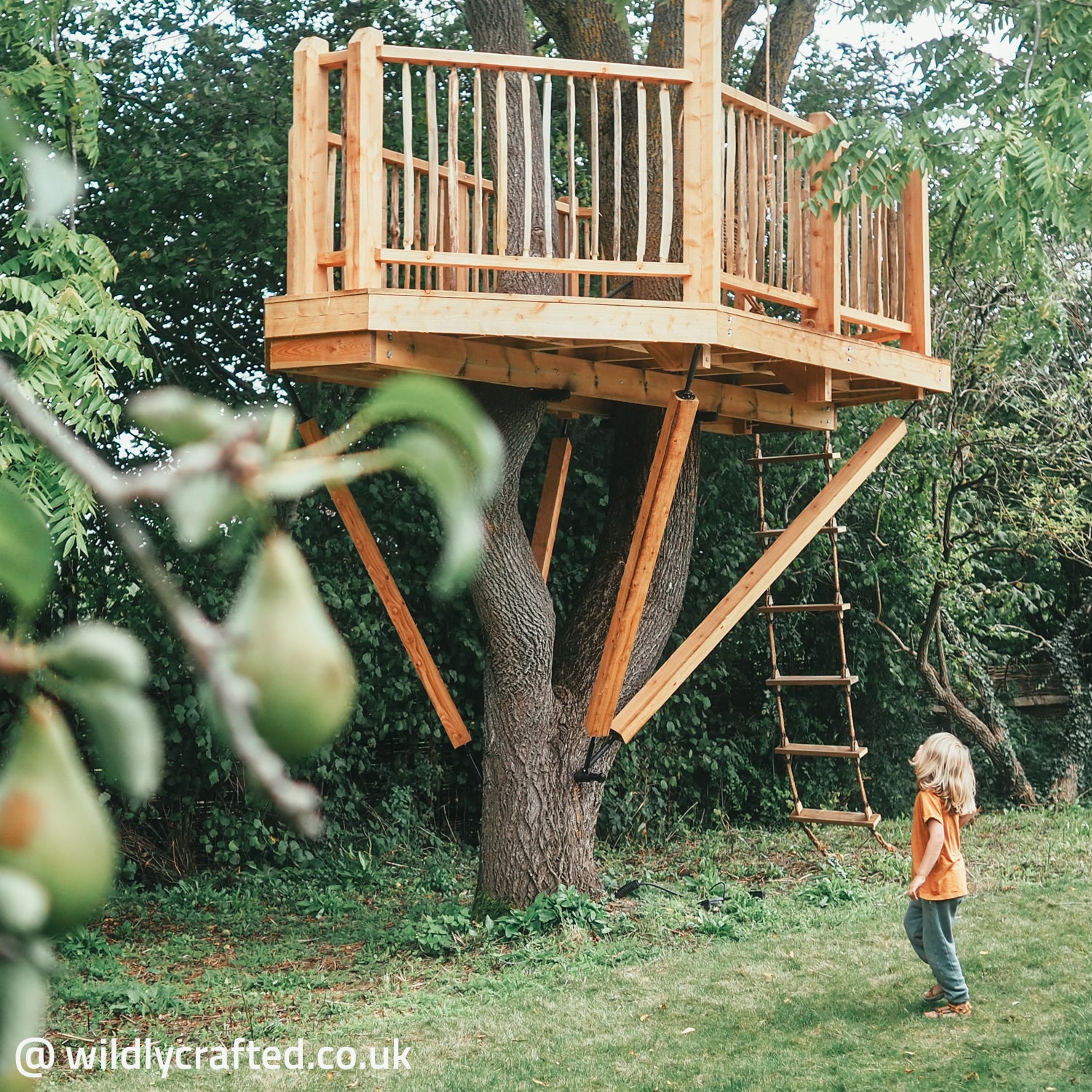
Lots of instructions – little expertise!
Screws, nails, hanging with cables or pressing the wooden beams to the tree with threaded rods? Treehouse building is booming, and there are countless DIY videos and building instructions on the Internet.
But be careful: Most of these projects show improper fastenings that not only damage the tree but can also be dangerous in the long term for treehouse visitors.
Luckily, you've come to the right place! We'll show you how real Treehouse Pros fasten their houses to trees – permanently, safely and without damaging the tree!
Buy professional hardware here!DIY enthusiasts and hardware stores such as Toom, Hornbach and Obi are jumping on the treehouse trend – but when it comes to securing them to trees, you usually only find dubious and outdated techniques!
The main problem is that the tree is prevented from growing naturally in thickness. Trees live, trees grow and trees need to move!
1. Not like this! Damage to the tree caused by incorrect fastening
Not only in DIY videos and home improvement blogs, but also in so-called ‘treehouse manuals’ and in climbing forests, you will repeatedly encounter fastenings that damage trees. All of these techniques hold and look good at first – but after 5 years at the latest, massive damage is visible – both to the tree and to the wooden structure.
The problem is always the same:
You opt for a fastening method that is initially inexpensive and quick. However, the rapid growth in thickness of the tree (3-15 mm annual ring width!) is ignored. As a result, the tree suffers from bruising and constriction of the tissue that transports water and nutrients. This creates dangerous predetermined breaking points on the tree and the contact surface of the wooden beams can rot and become a safety hazard.
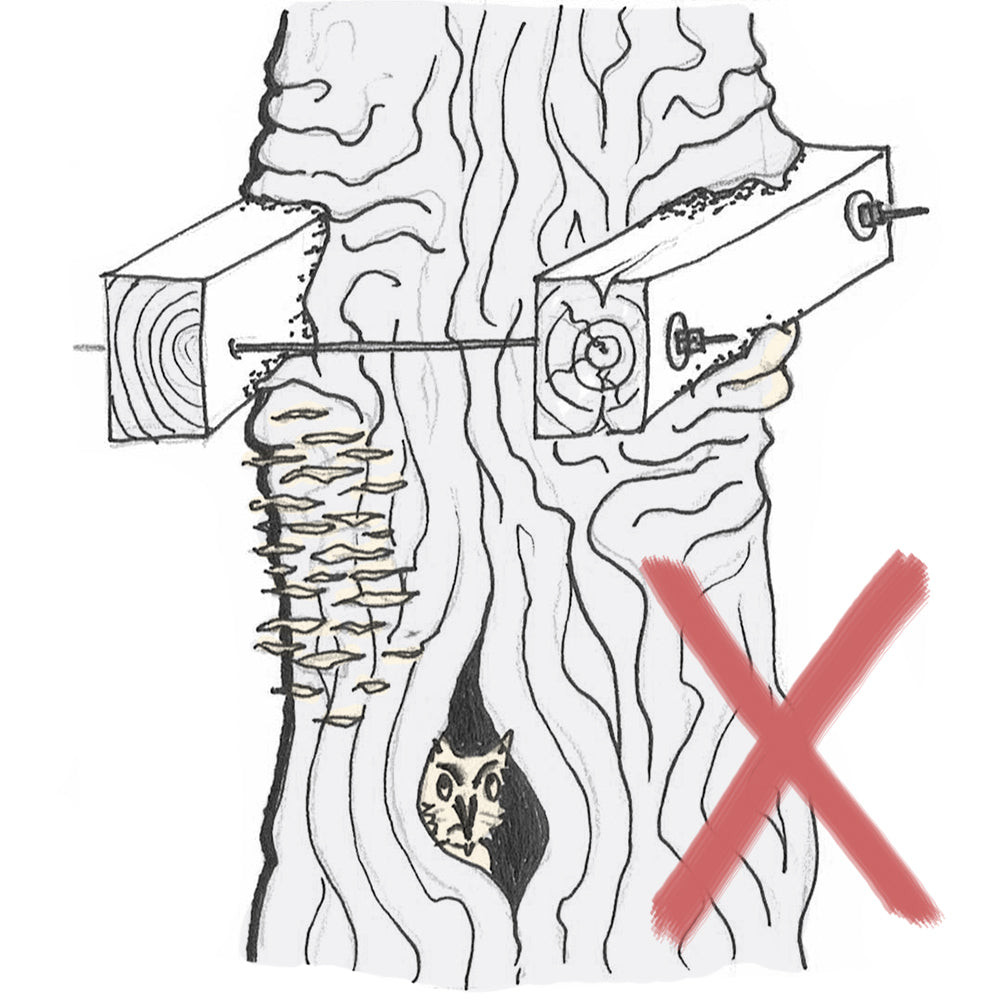
1. Not like this! Damage to the tree caused by incorrect fastening
Not only in DIY videos and home improvement blogs, but also in so-called ‘treehouse manuals’ and in climbing forests, you will repeatedly encounter fastenings that damage trees. All of these techniques hold and look good at first – but after 5 years at the latest, massive damage is visible – both to the tree and to the wooden structure.
The problem is always the same:
You opt for a fastening method that is initially inexpensive and quick. However, the rapid growth in thickness of the tree (3-15 mm annual ring width!) is ignored. As a result, the tree suffers from bruising and constriction of the tissue that transports water and nutrients. This creates dangerous predetermined breaking points on the tree and the contact surface of the wooden beams can rot and become a safety hazard.

Clamping techniques – not recommended!
The supposedly ‘injury-free’ clamping or pincer technique remains very popular. This involves clamping wooden beams or a steel ring firmly to the tree and holding them in place by pressure and friction. These platform fastenings are particularly common in climbing forests, high ropes courses and treetop trails, as the high number of platforms means that this initially quick and cheap construction method is used.
These fastenings should actually be readjusted every 2-3 years, but this is very time-consuming and costly and therefore hardly ever happens in practice! Ultimately, the platforms have to be dismantled very early on due to massive damage and the damaged tree can no longer be used for safety reasons.
For costly long-term projects lasting more than three years, we strongly advise against clamping techniques. There is ample evidence that these techniques are harmful and ineffective.
More and more operators of climbing forests, high ropes courses and treetop walkways are now having to deal with the consequences of these clamping techniques and are looking for solutions that are gentler on the trees.
Modern techniques such as tree bolts and TABs are more expensive to purchase. However, in the long term, they are gentler on trees and save a lot of time and maintenance costs.
2. Treehouse Screws – Modern All-Rounders
A true success story began around 30 years ago: the first treehouse bolts that would change our world forever were launched in the USA under the names ‘Garnier Limb’ and ‘Treehouse Attachment Bolt TAB’ – and modern treehouse construction was born!
Since then, tree bolts have become established among professional treehouse builders, climbing forest operators and a worldwide audience of DIY enthusiasts. They are proven to be the safest and most tree-friendly solution for long-term construction projects.
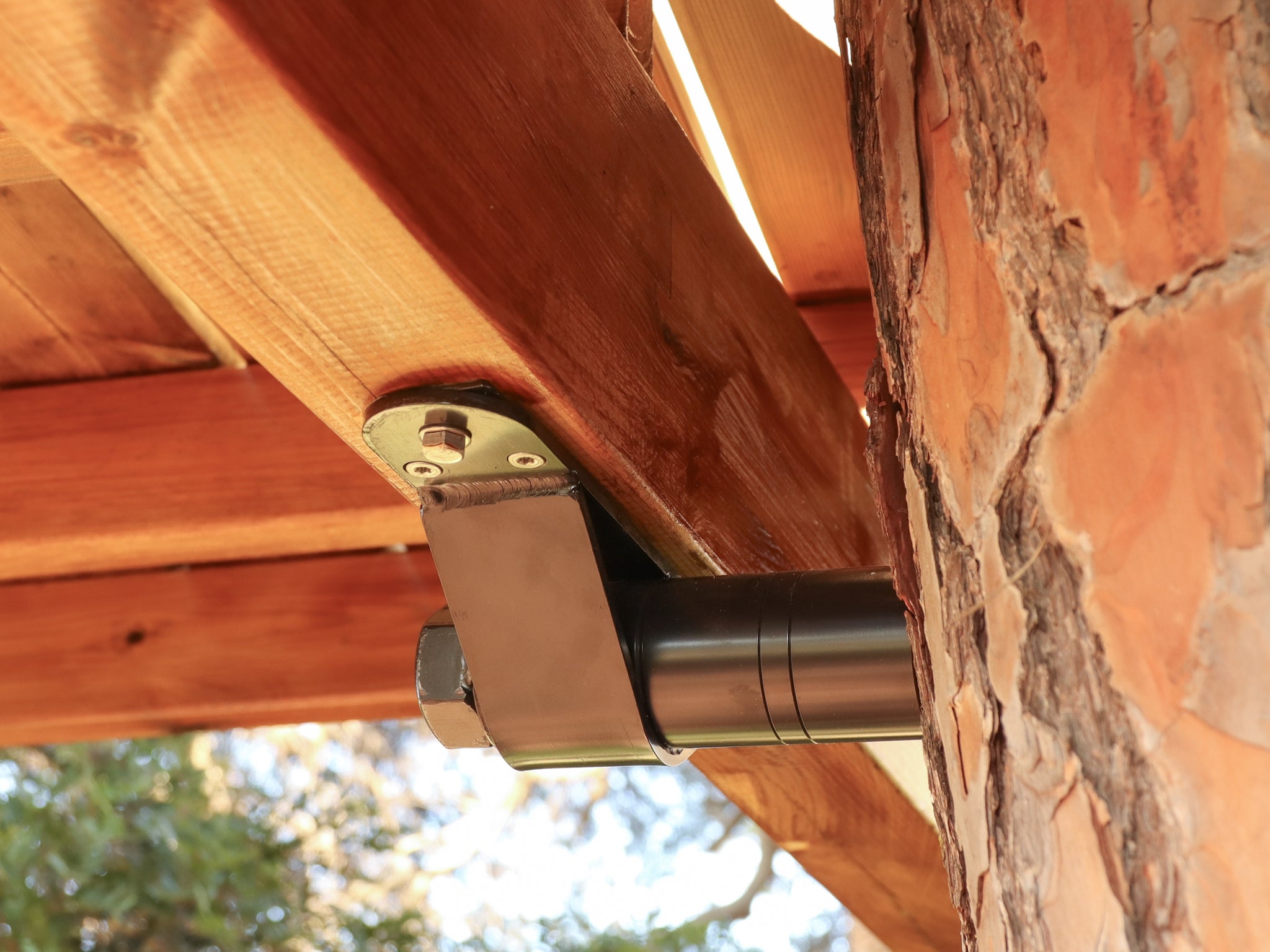
2. Treehouse Screws – Modern All-Rounders
A true success story began around 30 years ago: the first treehouse bolts that would change our world forever were launched in the USA under the names ‘Garnier Limb’ and ‘Treehouse Attachment Bolt TAB’ – and modern treehouse construction was born!
Since then, tree bolts have become established among professional treehouse builders, climbing forest operators and a worldwide audience of DIY enthusiasts. They are proven to be the safest and most tree-friendly solution for long-term construction projects.

German Treehouse Screw GTS
Tree bolts are the state of the art in treehouse construction. They offer maximum safety and are the best solution for permanent installations > 5 years.
The long shaft of the bolts provides plenty of space for attaching the support beams. The tree can grow undisturbed in width, as the beams are sufficiently spaced from the bark. Over the years, the tree bolt grows in and becomes an integral part of the tree - like a branch of its own!
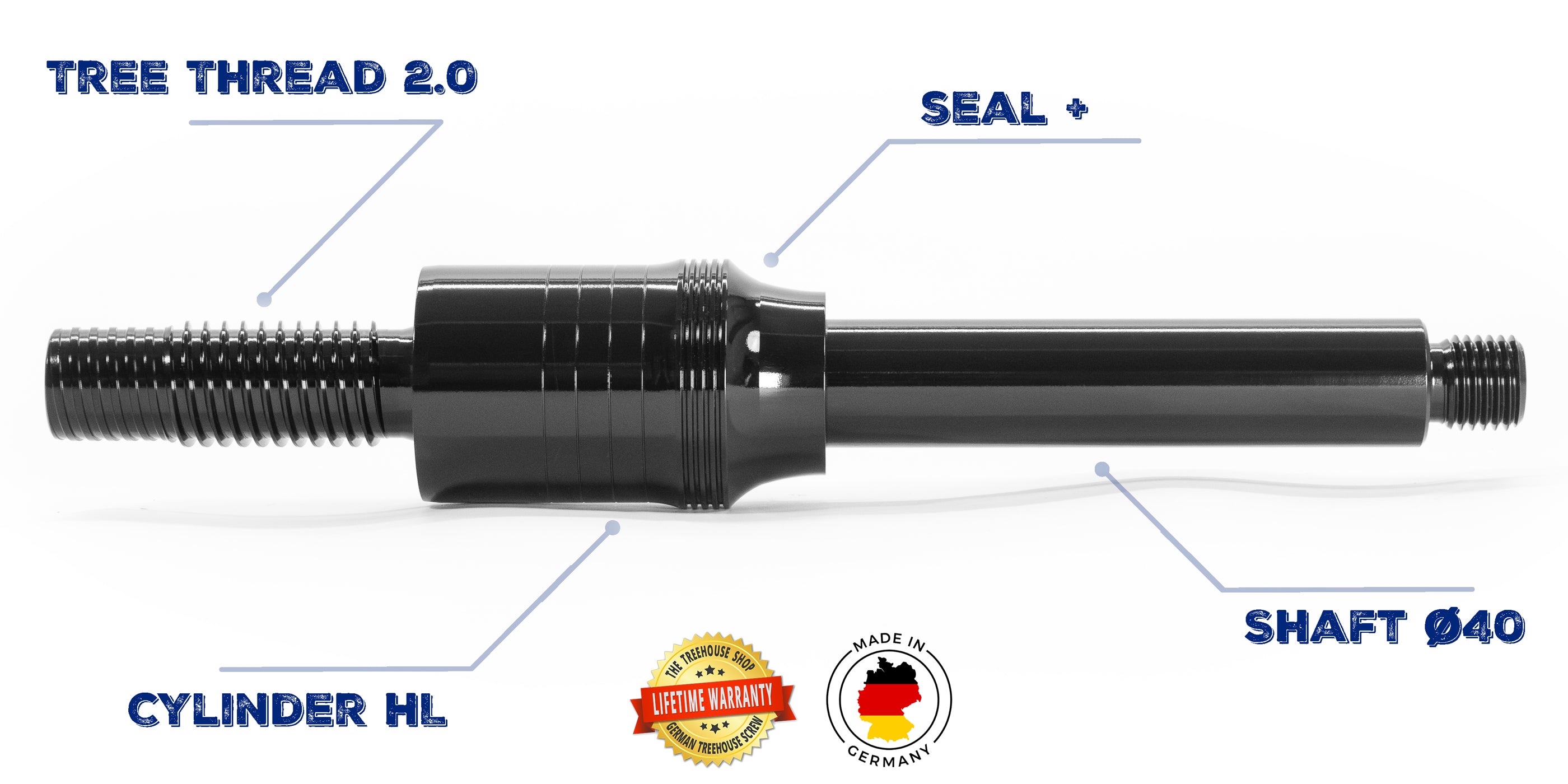 Buy GTS tree bolts!
Buy GTS tree bolts!
Advantages at a glance
✔ Fastening technology proven in practice for over 30 years
✔ Very high load capacity
✔ Sustainable and tree-friendly
✔ Durable, safe and low maintenance
✔ Extensive range of accessories – plenty of design freedom
✔ Trees remain flexible
✔ Aesthetic appearance of branches
✔ Possible overload is visibly indicated, allowing you to react appropriately at any time
Free growth in thickness
Only a few disadvantages
❌ Higher acquisition costs
❌ Only limited load capacity
Requirements for the tree
- The tree must be healthy and have good wound healing properties.
- The trunk diameter should be at least 30 cm (11.8 in).
Sample images of Treehouse Screws
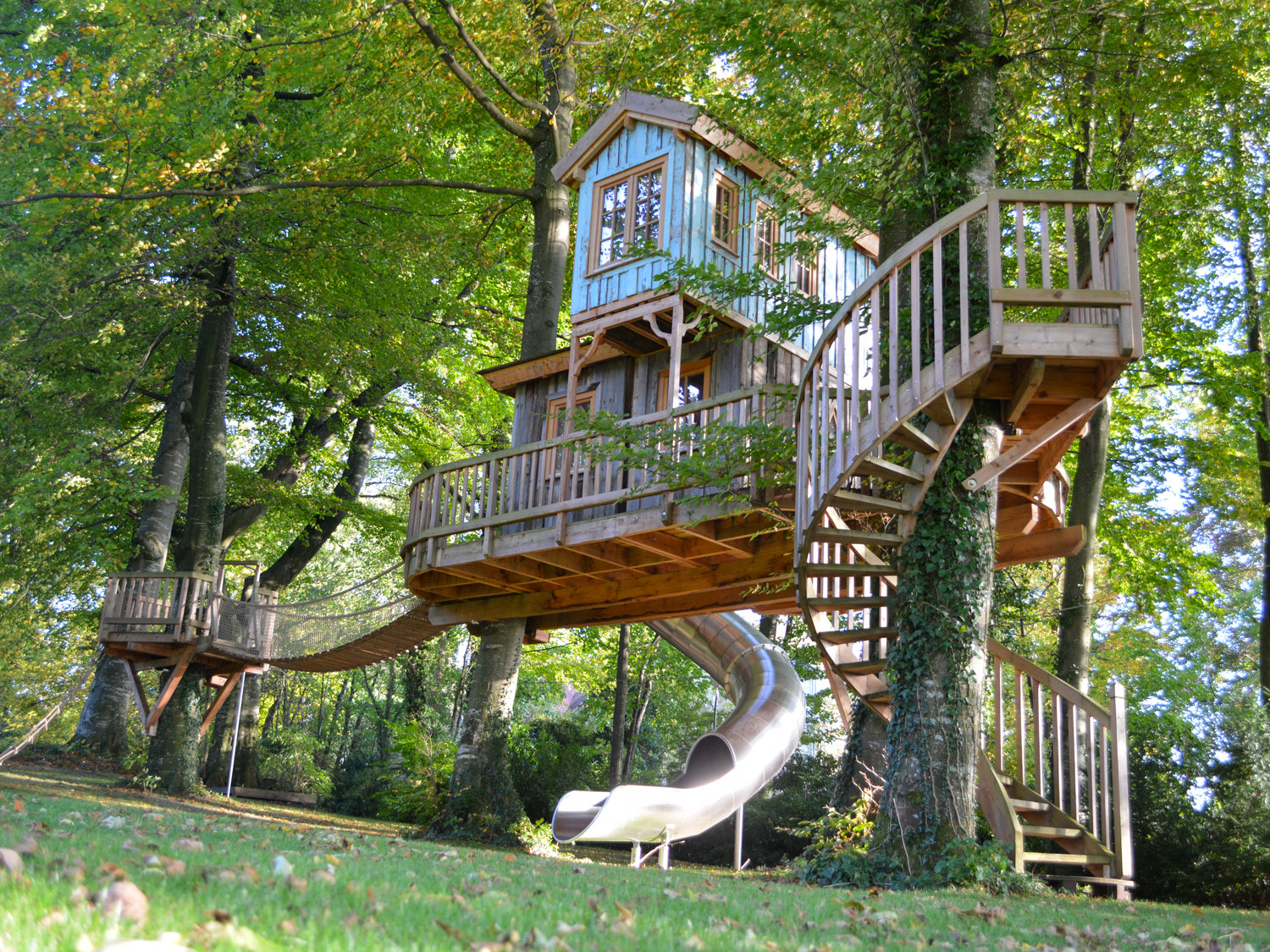
✔ Recommended by professionals and DIY enthusiasts
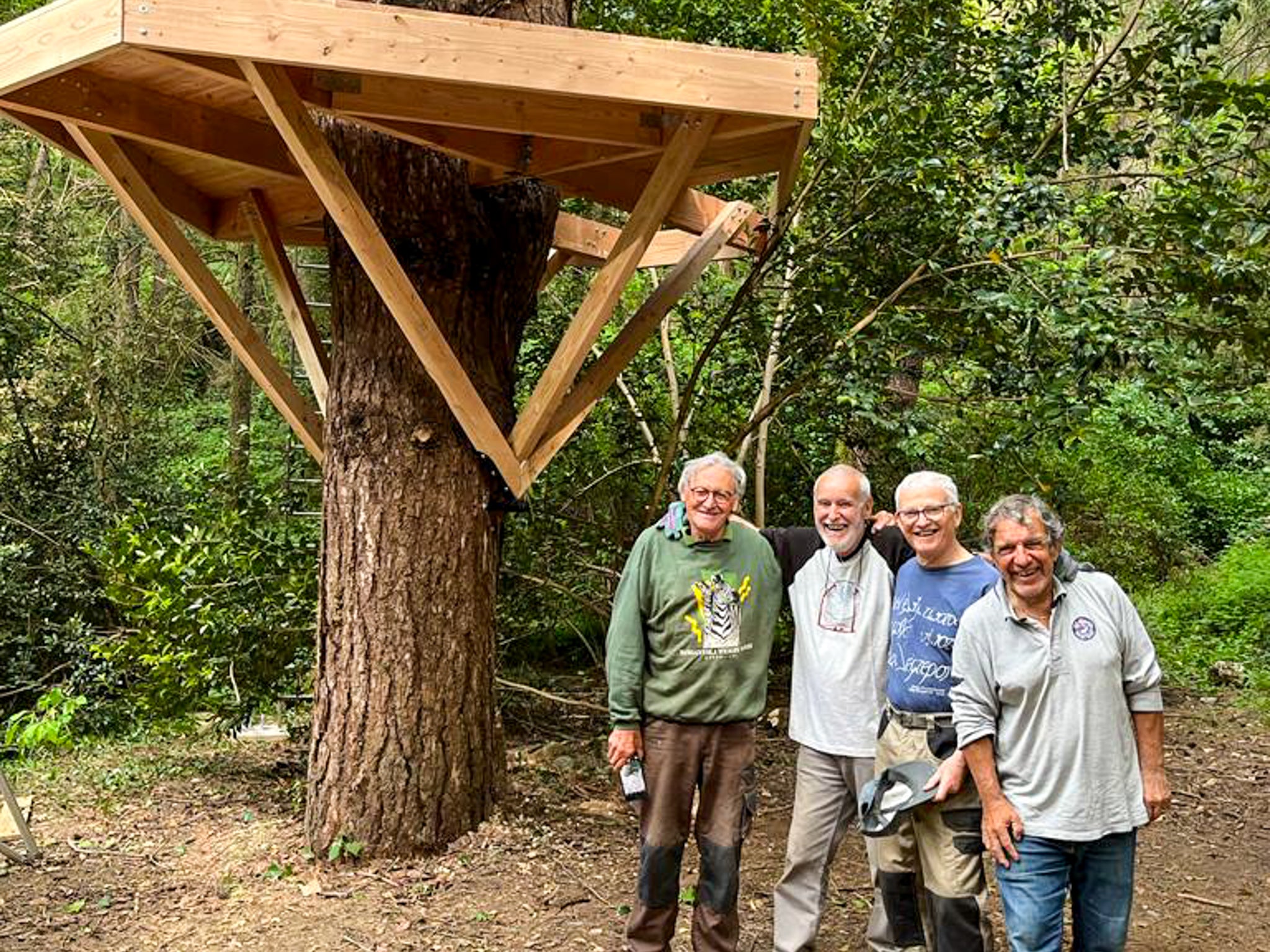
✔ Tried and tested: thousands of satisfied customers
3. Hanging a treehouse with tree support slings
A very elegant and damage-free method is to suspend the platform from the tree using steel cable and tree support slings.
This extra-wide strap distributes the load gently over a large area and prevents constriction. The tree support sling is placed around a forked branch (preferably a U-shaped fork) or a stable branch fork. At the lower end, the cable is connected to the support beam. The desired length is adjusted using a turnbuckle.
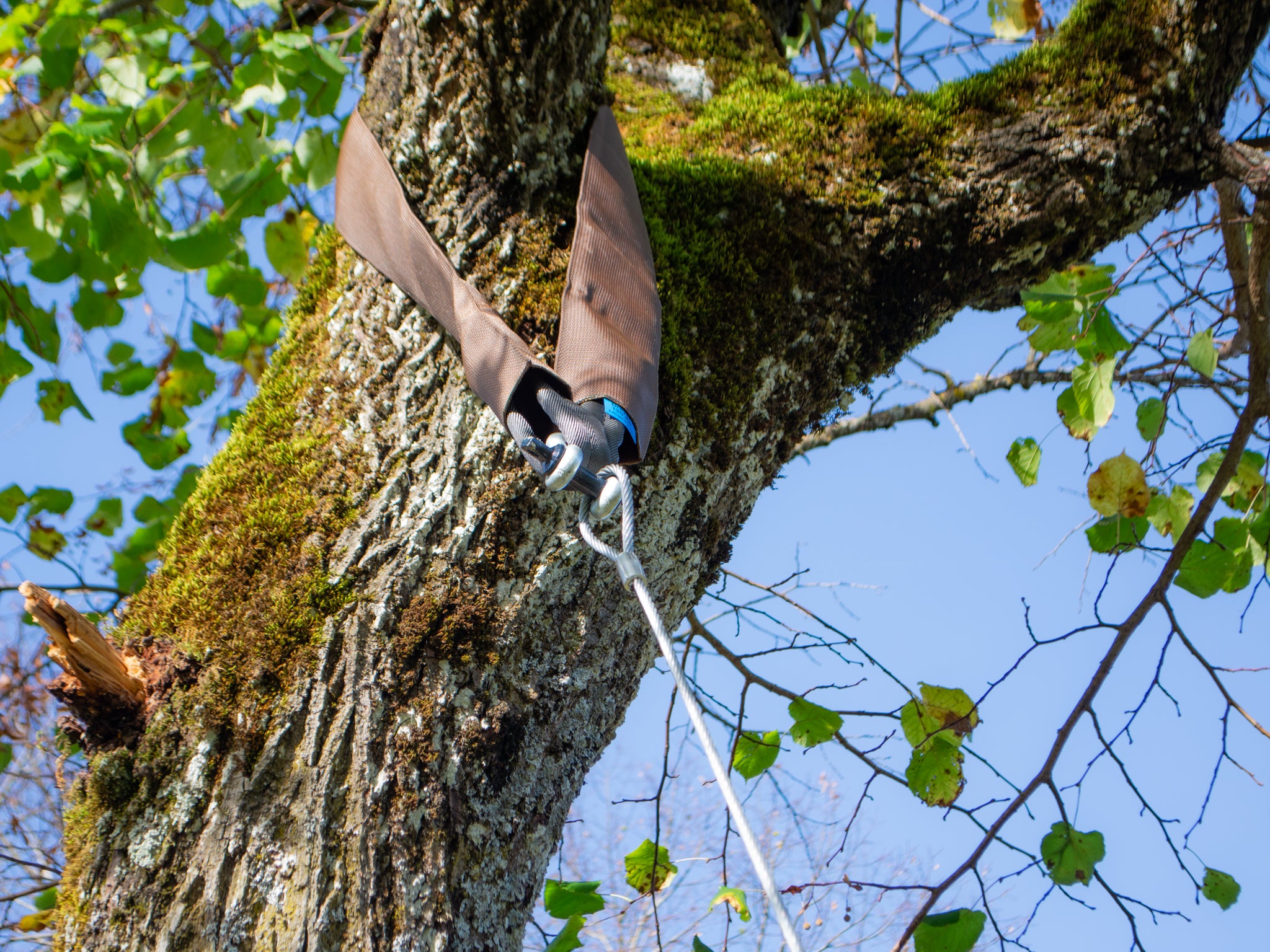
3. Hanging a treehouse with tree support slings
A very elegant and damage-free method is to suspend the platform from the tree using steel cable and tree support slings.
This extra-wide strap distributes the load gently over a large area and prevents constriction. The tree support sling is placed around a forked branch (preferably a U-shaped fork) or a stable branch fork. At the lower end, the cable is connected to the support beam. The desired length is adjusted using a turnbuckle.

Use of rope suspensions
Rope fastening is a good choice for temporary installations < 5 years and trees whose wood is unsuitable for tree bolts, e.g. willow, poplar and similar trees with very soft wood or poor wound reaction.
We consider it too risky to secure a large treehouse with cables alone, firstly because it is very susceptible to vibration and secondly because damaged cables can break without warning.
Cables are therefore ideal in combination with other fasteners or for additional securing of particularly stressed components!
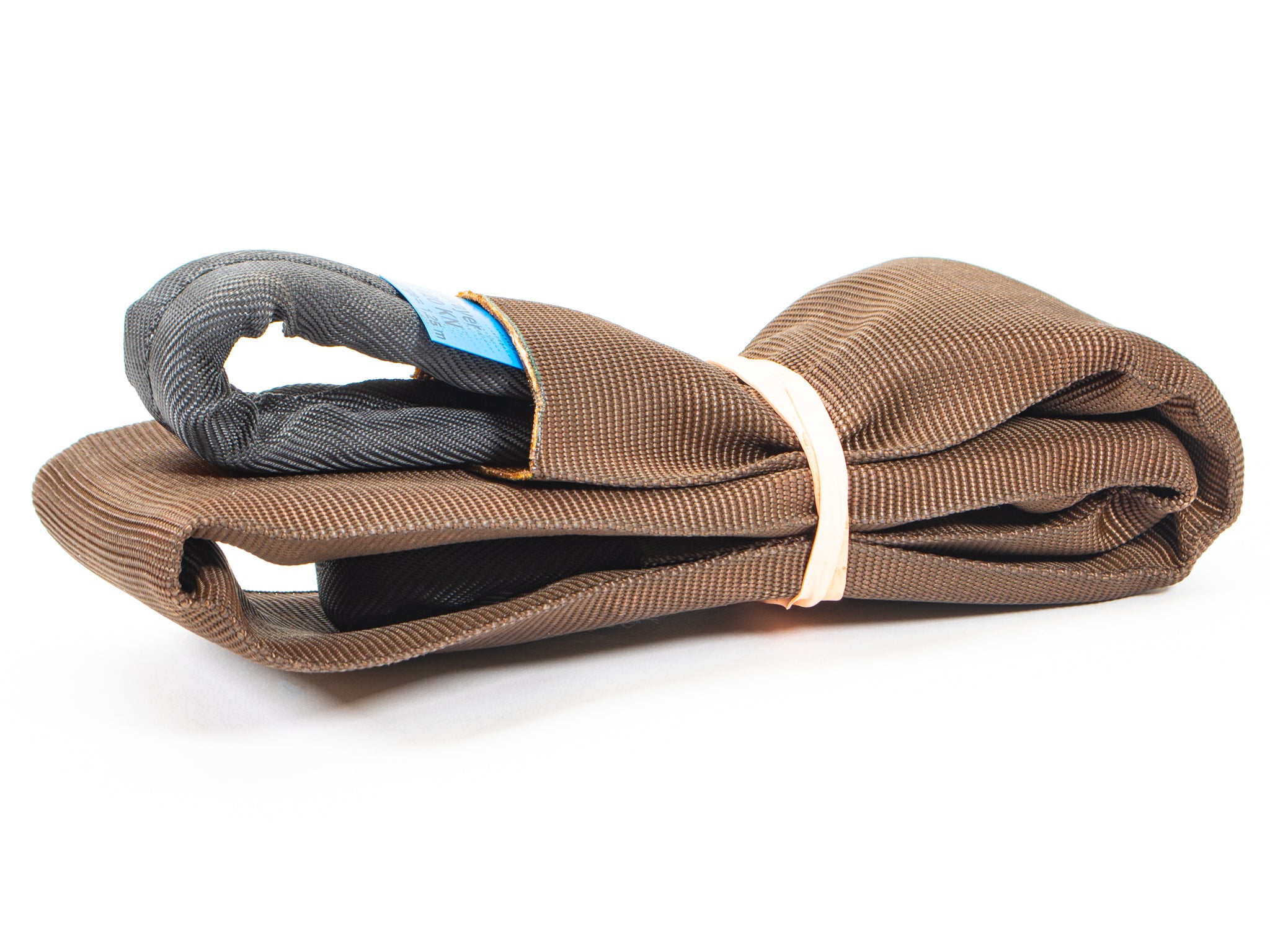 Buy Tree Support Slings here!
Buy Tree Support Slings here!
Advantages of Tree Support Slings
✔ Standardised fastening technology from tree care
✔ High load capacity with direct load transfer to the trunk (4–8 tonnes)
✔ No open wounds
✔ Low costs
✔ Tree can move freely
✔ Easy installation
✔ Height adjustment possible at a later date with turnbuckle
✔ Ideal for retrofitting and as additional security for heavily loaded components
✔ Perfect for attaching suspension bridges to trees!
disadvantages
❌ Dependent on the growth habit of the tree
❌ Less design freedom
❌ The rope may be unsightly
❌ Prone to swinging in storms – the tree and wooden structure may be damaged
❌ Tree support slings can also grow into the tree over time
❌ Cable, forked branches or branch forks can fail suddenly and without visible warning (tree bolts, on the other hand, deform the wood slowly and give warning of their failure)
❌ Tree Support Slings must be replaced every 8 years in accordance with DIN
Requirements for the tree
- Trees with thick, resistant bark, such as oak and chestnut, are well suited.
- Less suitable are beech and willow, for example, as their thin bark offers little protection against abrasion.
- Very windy locations should be avoided, as the tree and treehouse can swing heavily.
Assembly instructions
- The anchor point should be as close to the trunk as possible, a U-shaped fork or a strong branch fork
- Avoid large lever arms
- The cable should be as vertical as possible (angle < 25°)!
- The higher up in the tree and the longer the cable, the stronger and more uncontrollable the vibrations!
4. Treehouse on stilts
Stilts are used when there are doubts about the load capacity or health of the tree.
Depending on the cross-section of the stilts, very high loads can be supported. This in turn allows the use of heavy materials that are particularly attractive in the luxury sector (stone slabs, large window areas, bathtubs, etc.).
Stilts are also a good choice in public areas where large crowds are expected, as they can be officially calculated by a structural engineer.
For trees that are too small, a combination of stilts and tree fastening is often the most sensible solution.
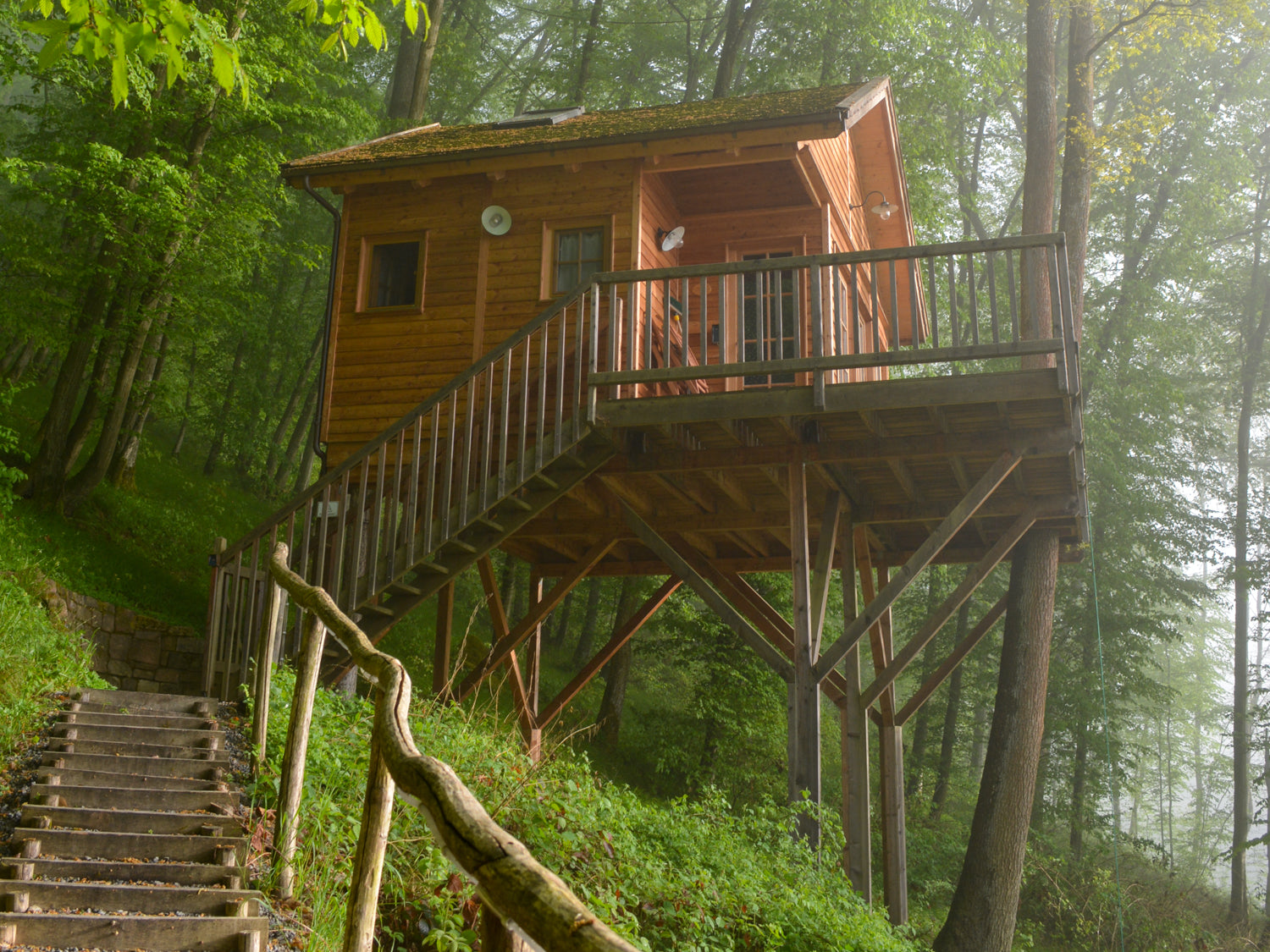
4. Treehouse on stilts
Stilts are used when there are doubts about the load capacity or health of the tree.
Depending on the cross-section of the stilts, very high loads can be supported. This in turn allows the use of heavy materials that are particularly attractive in the luxury sector (stone slabs, large window areas, bathtubs, etc.).
Stilts are also a good choice in public areas where large crowds are expected, as they can be officially calculated by a structural engineer.
For trees that are too small, a combination of stilts and tree fastening is often the most sensible solution.

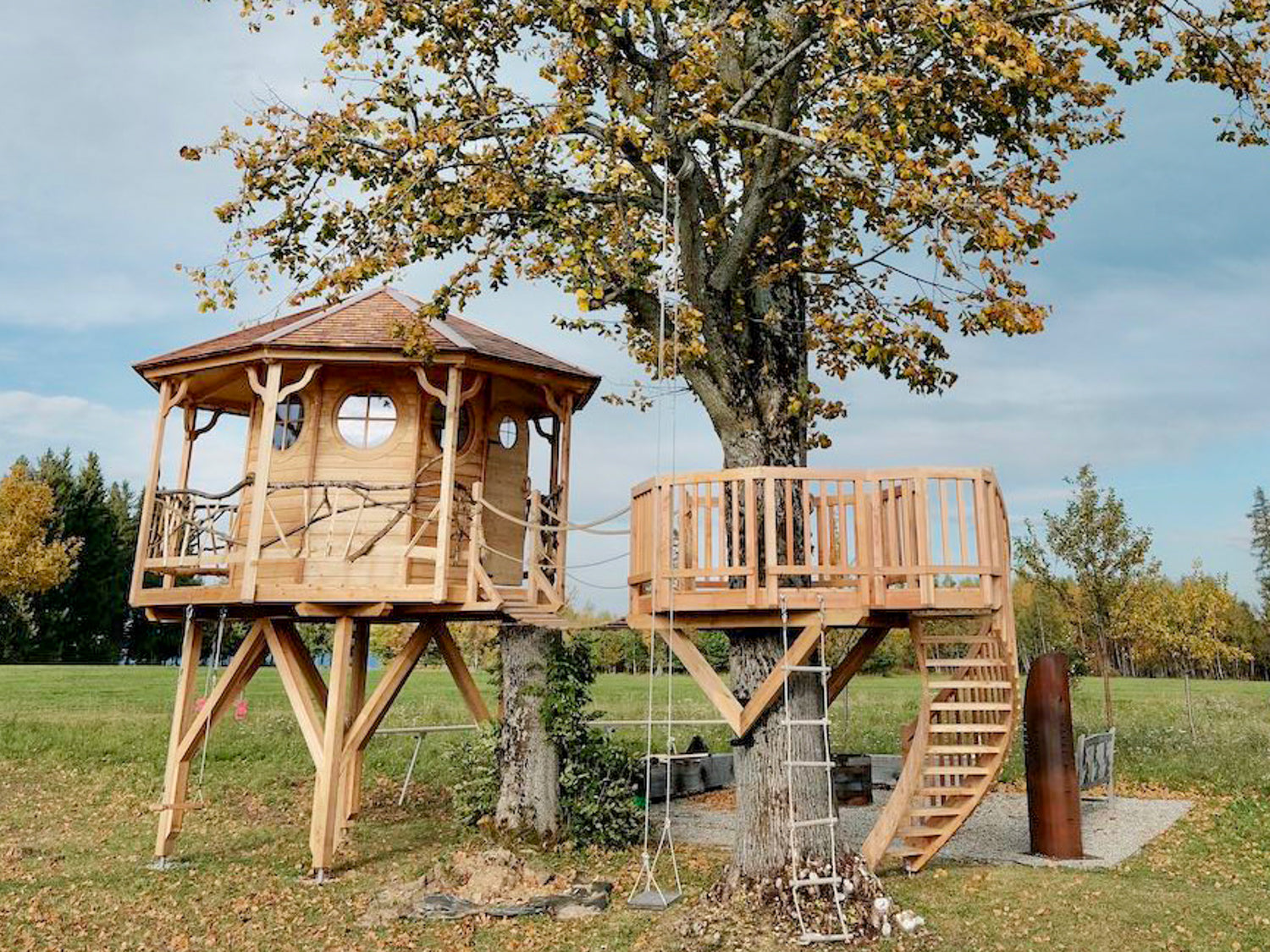
✔ This tree no longer has a healthy crown – it would be better to build the treehouse on stilts here.
Building a treehouse on stilts and foundations
Normal wooden beams are secured to the concrete foundation with post shoes (post anchors). The end grain should be at least 15 cm away from the foundation and able to dry thoroughly if splashed with water. The foundations are best covered with bark mulch or gravel to prevent dirty splashes.
An exception to this are robinia/acacia logs, which can also be concreted directly into the foundation due to their stability. Naturally grown round logs also look very attractive!
Advantages of stilts & support posts
✔ Structural stability easy to calculate – ideal for public projects
✔ Very safe
✔ Robust and heavy construction possible
✔ Tree trunk remains intact
✔ Easy to assemble
✔ No objections from conservationists
disadvantages
❌ Not a ‘real’ floating treehouse
❌ Supports and struts detract from the aesthetics
❌ Risk of root damage from earthworks and concrete foundations
Note on foundations and roots
The roots are very important for the nutrient supply and health of the tree. If a thick root is cut off, it is roughly equivalent to the loss of a branch of the same thickness! Therefore: The foundations should be at least 1.5 m (4.9 ft) away from the tree and neighbouring trees – so that the large roots are not damaged!
- For normal treehouses and normal soil, the foundations must be at least 40 cm (15.7 in) in diameter and 70 cm deep (frost protection).
- For small, lightweight children's playhouses, horticultural concrete/quick-setting concrete is sufficient.
- For heavier loads, use normal concrete, possibly with light reinforcement (load-bearing after approx. 12 hours).
Wooden post dimensions
Two factors essentially determine the dimensions of the wooden beam:
1. The load
- For normal treehouses, a beam cross-section of 12 x 12 cm with a length of approx. 2 m is sufficient.
- For very high loads, 14 x 14 cm
- For light children's playhouses, 10 x 10 cm is sufficient
2. The length / bending stress
- The longer the supports, the greater the risk that they will bend under load and buckle sideways, therefore:
- Choose wooden posts that are longer than 3 m (9,8 ft) + 2 cm thicker.
Important: Install struts and brackets
- To prevent longer posts ( > 1 m) from tilting sideways, struts must be installed.
- These stiffen the construction and reduce the buckling length of the supports.
5. Threaded rods – Only recommended in certain circumstances
Through-bolting as a rope anchor:
This technique originated in the USA and was used extensively in the 1990s for crown protection. A threaded rod (ø 20 to 40 mm) is drilled completely through the tree and secured with a washer and lock nut. However, this method has fallen into disrepute among arborists because drilling through the tree can cause core rot in both directions. The technique has been largely replaced by modern, damage-free straps. Handbook of Tree Statics, 2023 - Thomas Sinn
Threaded rods for attaching platforms?
For very small, very light platforms with low loads (e.g. in climbing forests, 2 m² with two people), the load capacity of a threaded rod with a diameter of 24 mm is still sufficient. However, the problem is that due to the low load capacity, the wooden beams cannot be spaced apart – the beams that are in direct contact with the tree hinder the growth of the tree and cause damage in the long term.
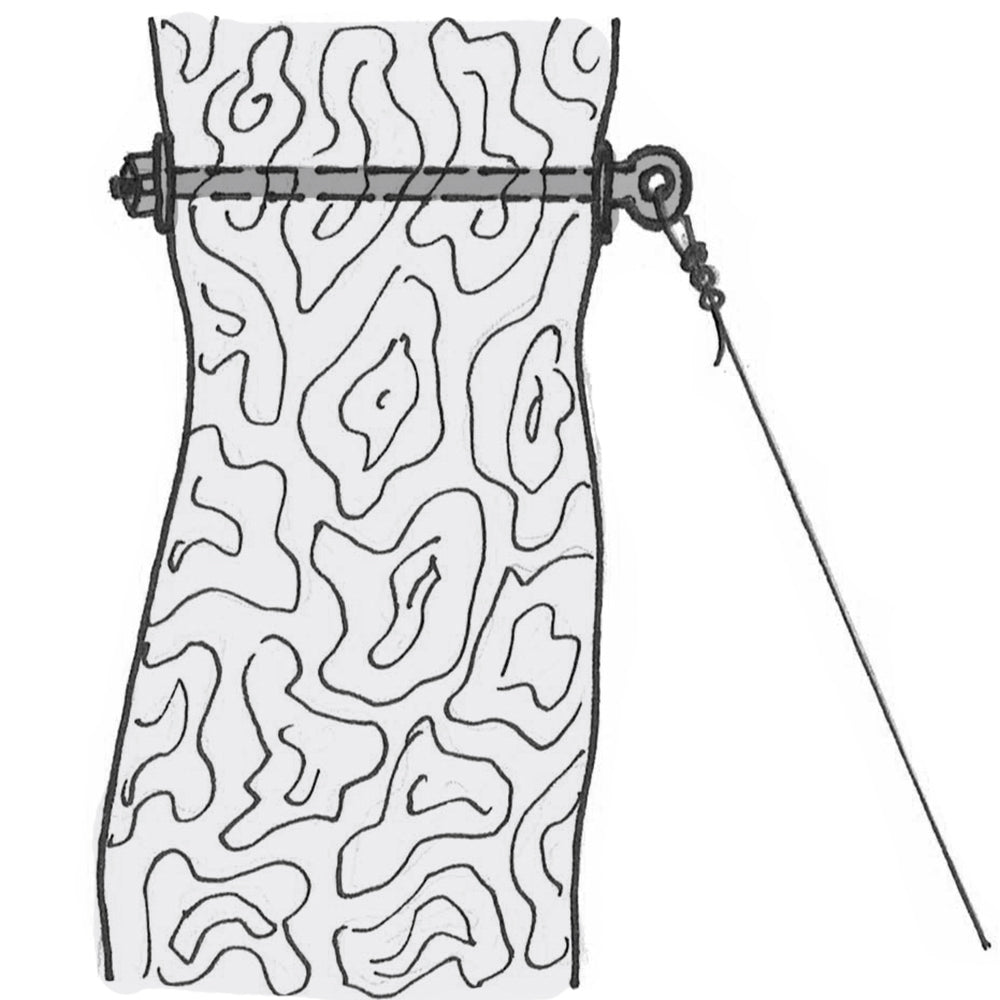
5. Threaded rods – Only recommended in certain circumstances
Through-bolting as a rope anchor:
This technique originated in the USA and was used extensively in the 1990s for crown protection. A threaded rod (ø 20 to 40 mm) is drilled completely through the tree and secured with a washer and lock nut. However, this method has fallen into disrepute among arborists because drilling through the tree can cause core rot in both directions. The technique has been largely replaced by modern, damage-free straps. Handbook of Tree Statics, 2023 - Thomas Sinn
Threaded rods for attaching platforms?
For very small, very light platforms with low loads (e.g. in climbing forests, 2 m² with two people), the load capacity of a threaded rod with a diameter of 24 mm is still sufficient. However, the problem is that due to the low load capacity, the wooden beams cannot be spaced apart – the beams that are in direct contact with the tree hinder the growth of the tree and cause damage in the long term.

Sample images - Threaded rods in a tree
Threaded rods are unsuitable for heavy loads such as treehouses:
❌ Threaded rods do not have a load-bearing tree thread.
❌ The continuous thread creates many weak points (predetermined breaking points).
❌ Threaded rods are not suitable for dynamic loads in trees.
❌ The wooden structure cannot be spaced because threaded rods bend under heavy lever loads.
Threaded rods are unsuitable for the high dynamic loads in treehouse construction because their load capacity and safety are too low.
6. Conclusion – The 5 golden rules for fastening to trees
Whether for heavy platforms, treehouses, climbing forests or high ropes courses – with a well-designed and tree-friendly fastening system, you can still enjoy your project in 20 years!
So-called ‘injury-free’ slings and clamping techniques may seem attractive at first glance, but in the long term they cause massive damage to the tree.
‘Damaging’ methods (e.g. GTS Tree Bolts) may seem daunting at first, but in the long run (> 3 years) they are clearly the better choice:
✔ Sustainable and safe
✔ Extremely high load capacity
✔ The wooden beams are spaced away from the tree
✔ The tree has room to grow
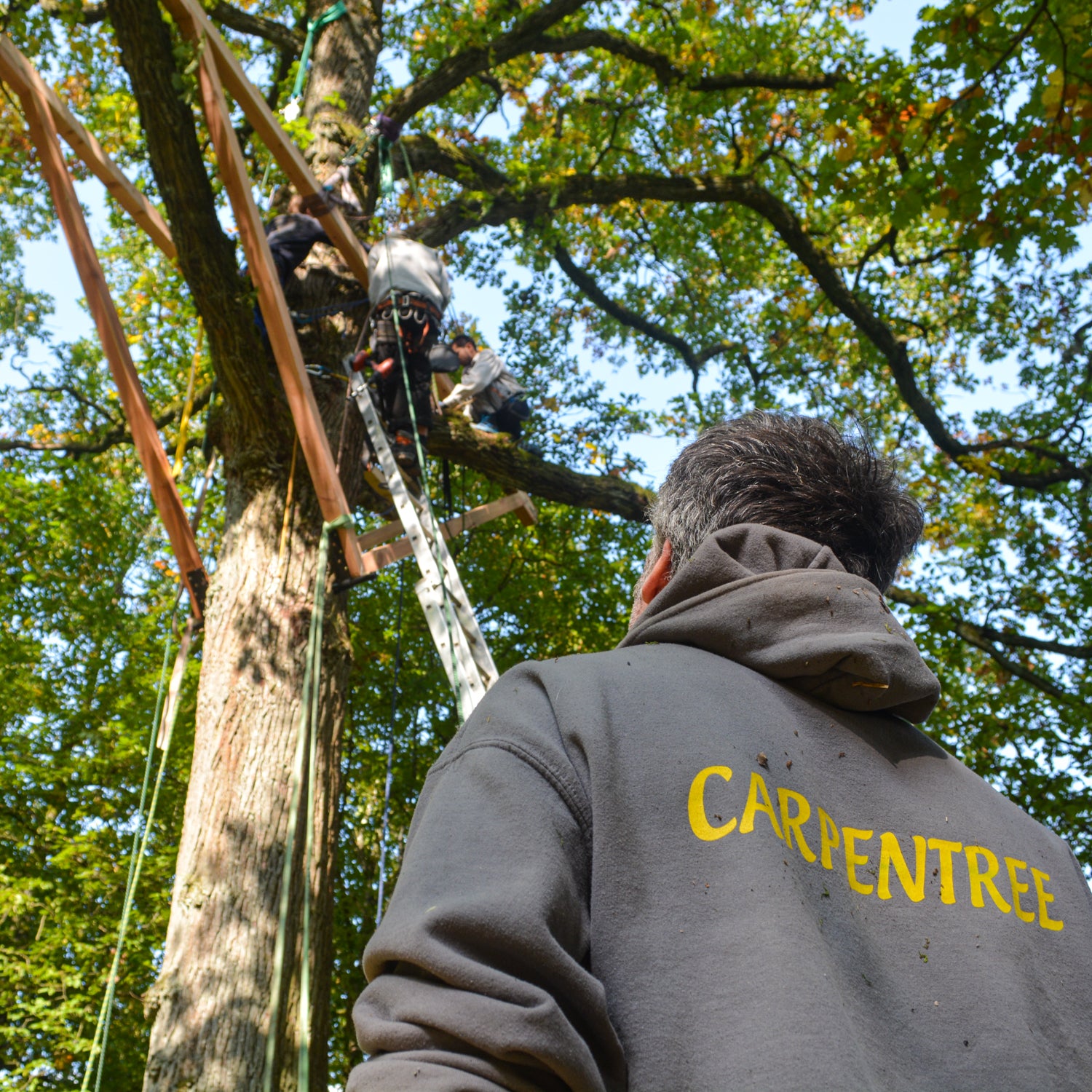
6. Conclusion – The 5 golden rules for fastening to trees
Whether for heavy platforms, treehouses, climbing forests or high ropes courses – with a well-designed and tree-friendly fastening system, you can still enjoy your project in 20 years!
So-called ‘injury-free’ slings and clamping techniques may seem attractive at first glance, but in the long term they cause massive damage to the tree.
‘Damaging’ methods (e.g. GTS Tree Bolts) may seem daunting at first, but in the long run (> 3 years) they are clearly the better choice:
✔ Sustainable and safe
✔ Extremely high load capacity
✔ The wooden beams are spaced away from the tree
✔ The tree has room to grow

The 5 golden rules for fastening treehouses
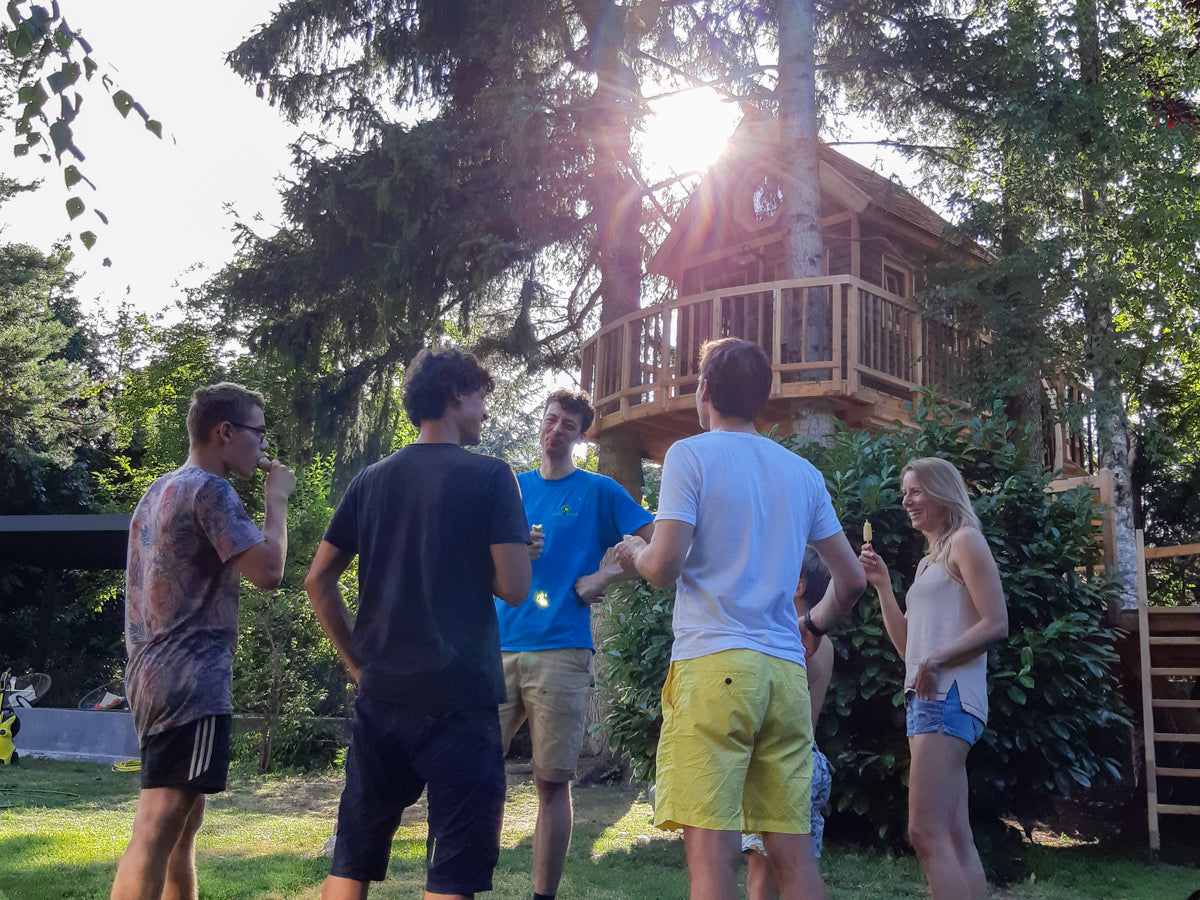
1. Long-term planning pays off!
Anyone who invests a lot of time, love and money in a construction project wants to enjoy it for a long time! A well-designed treehouse that respects the tree and its growth will last at least a lifetime ;)
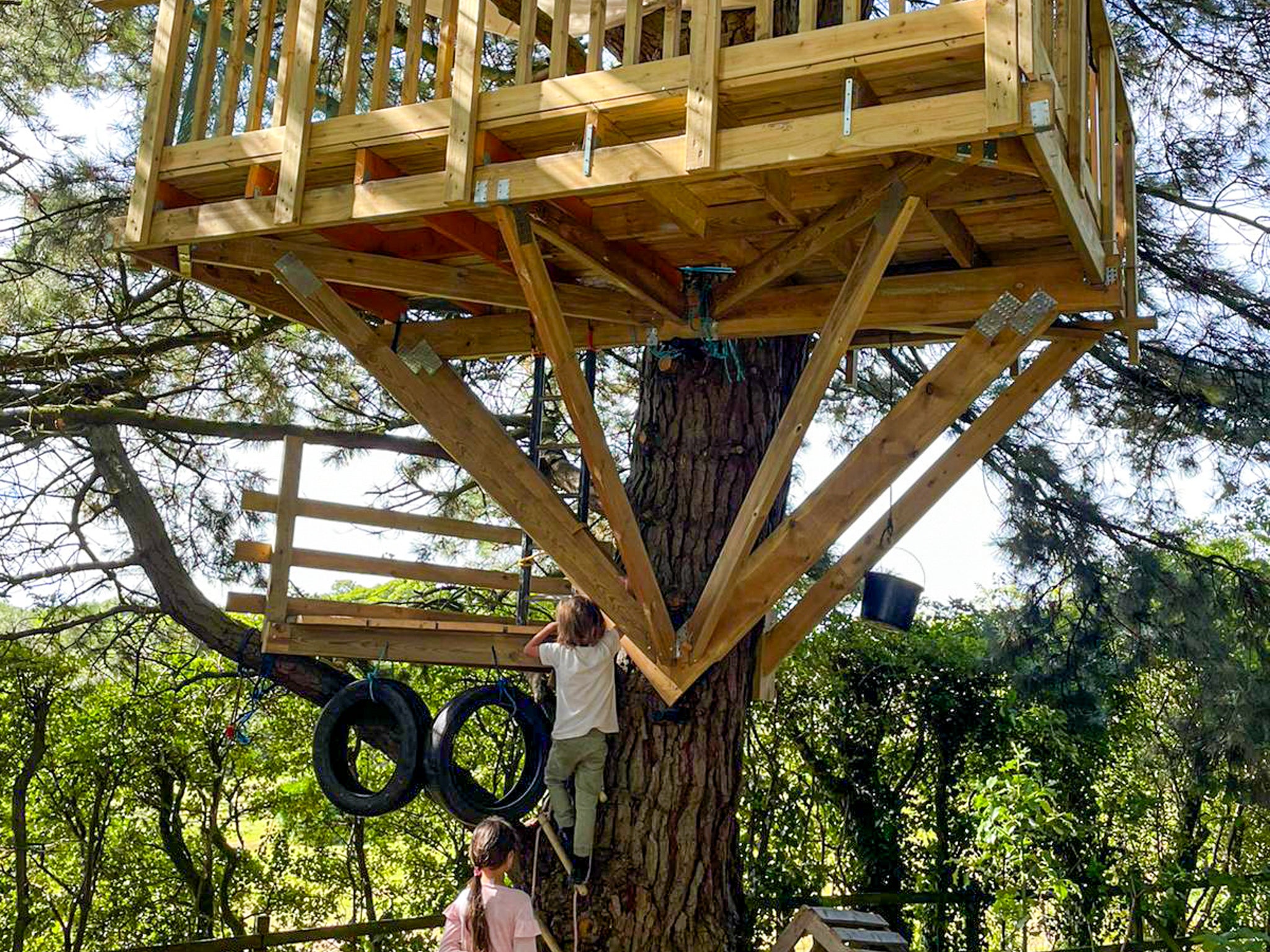
2. Healthy and large tree
The tree must be completely healthy and fully grown. The trunk should have a diameter of > 30 cm (11.8 in) at the height of the platform.
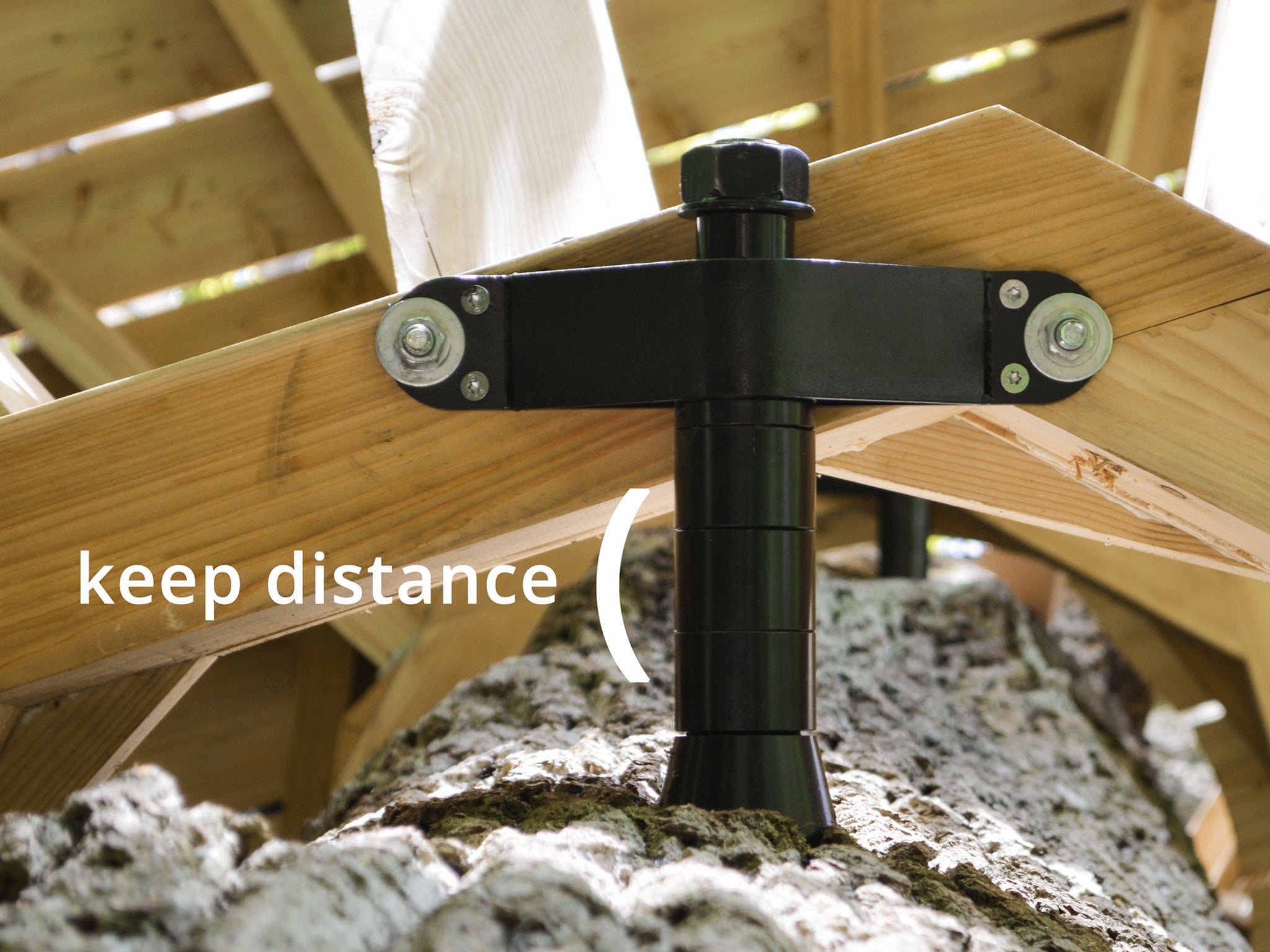
3. Maintain sufficient distance
The tree grows an average of 3–15 mm in width each year. The less it is restricted, the better!

4. Consider movement
If there are several trees, plan the movements so that neither the trees nor the wooden structure are damaged in a storm.
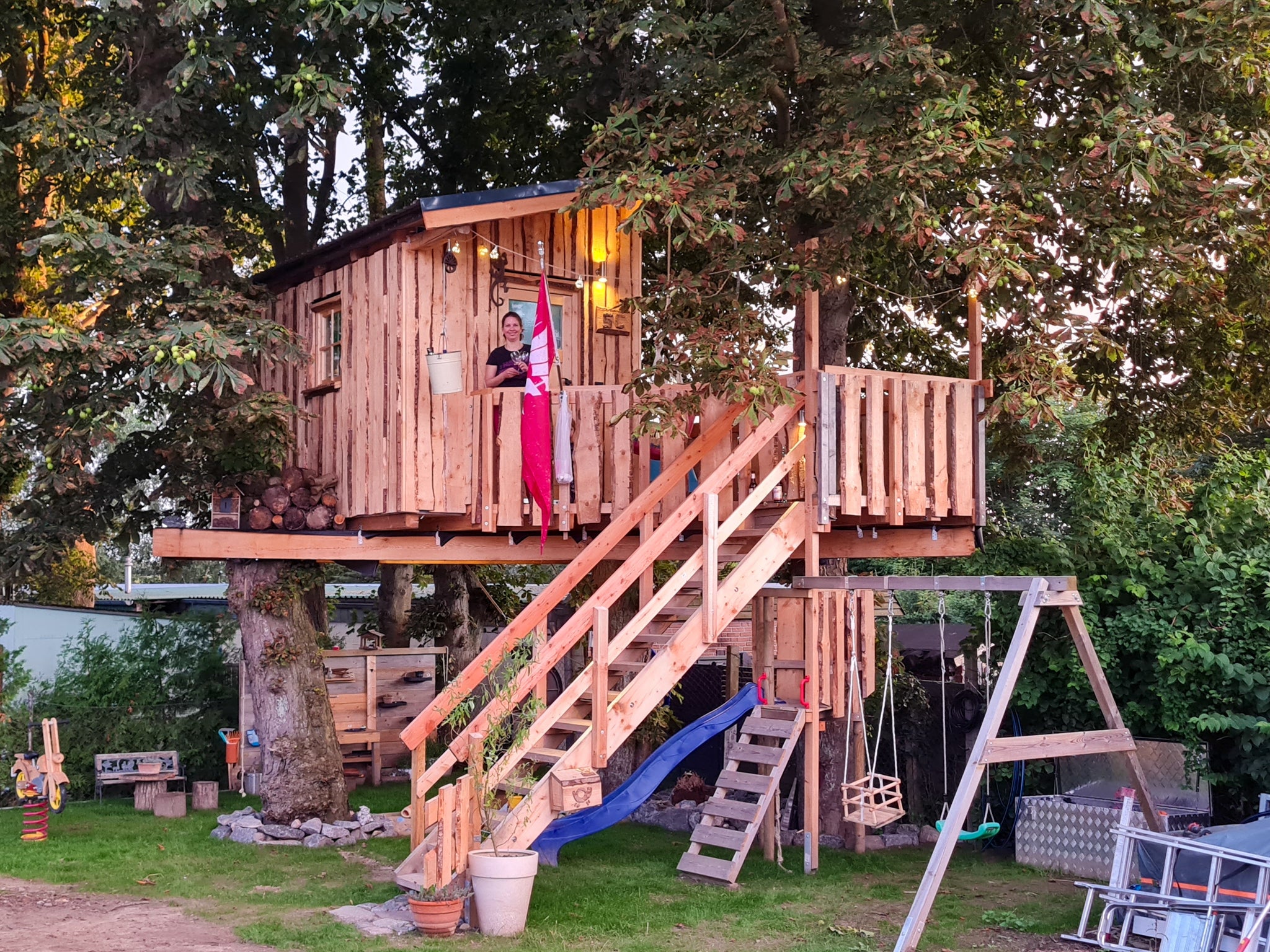
5. The size must be right
The treehouse must be appropriate for the size of the tree and must not ‘crush’ it – it is better to plan something smaller or build on stilts.
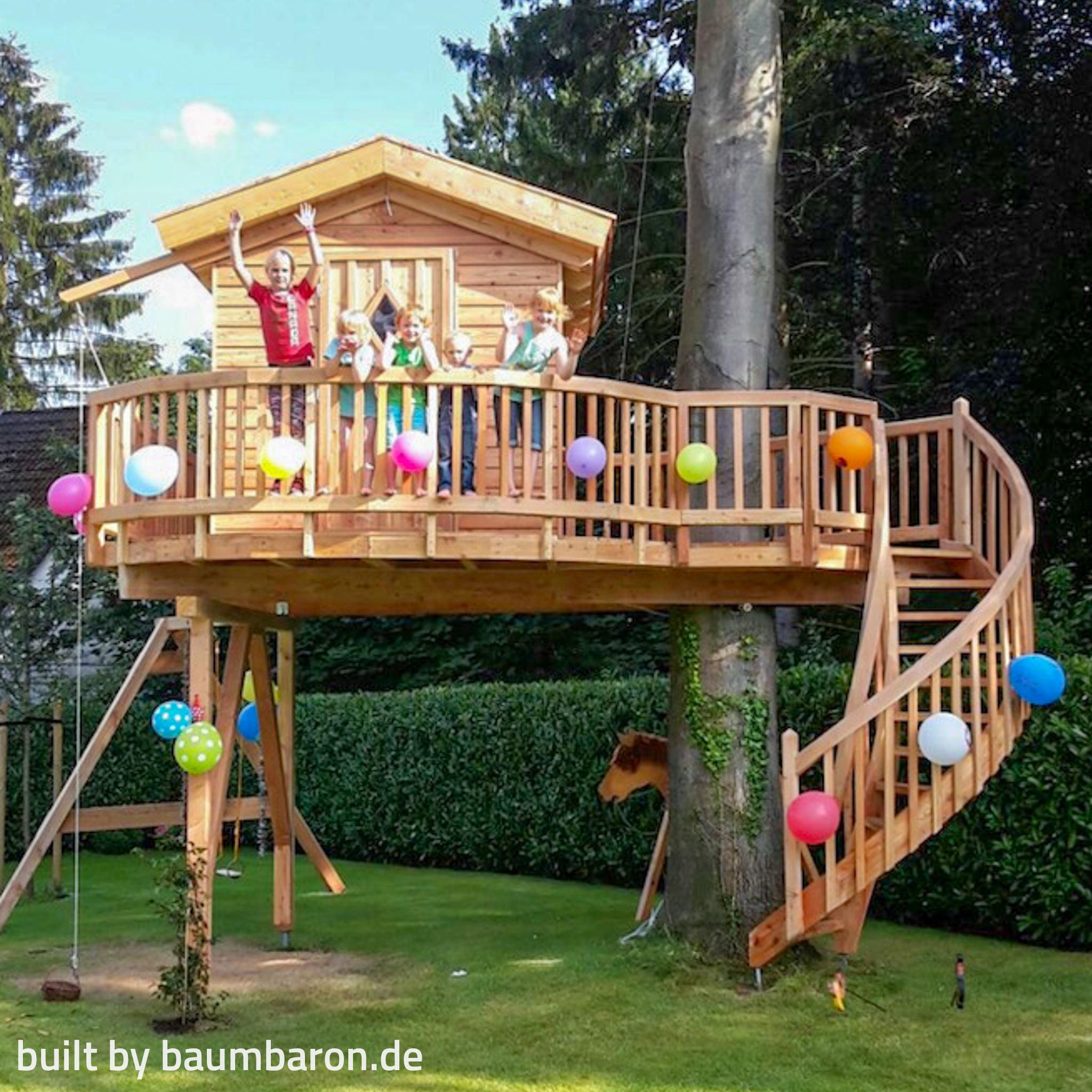

The perfect treehouse tree
This beech tree is ideal for fastening with tree bolts – healthy and with a thick trunk!
GTS Baumhaus-Hardware
The GTS Tree Bolts have been specially developed for living trees.
Combining methods
As this tree is close to the neighbour's boundary, the combination of tree fastening and stilts is the ideal solution here.
Happy treehouse dwellers
Take a look at what our customers have already built!
Building platform
We'll show you how to build a safe and stable platform for your treehouse!
There is a solution for every tree and every treehouse! Ultimately, the situation on site determines which fastening is most suitable for the project in question.
Trees live, trees grow and want to move! The more freely and naturally the tree trunk can grow in width, the better!
A well-designed treehouse can last well over 20 years! If you want to enjoy your treehouse for a long time, you need to consider the health of the tree!
